Nth Geelong -Warrenheip

North Geelong to Warrenheip gradient diagram
1967 Bannockburn to Yendon signal diagram
1983 Gheringhap to Yendon signal diagram
The section North Geelong to Ballarat was opened for traffic April 11 1862, as built it was double line. Between 1907 and the 1930s the line was progressively single tracked.
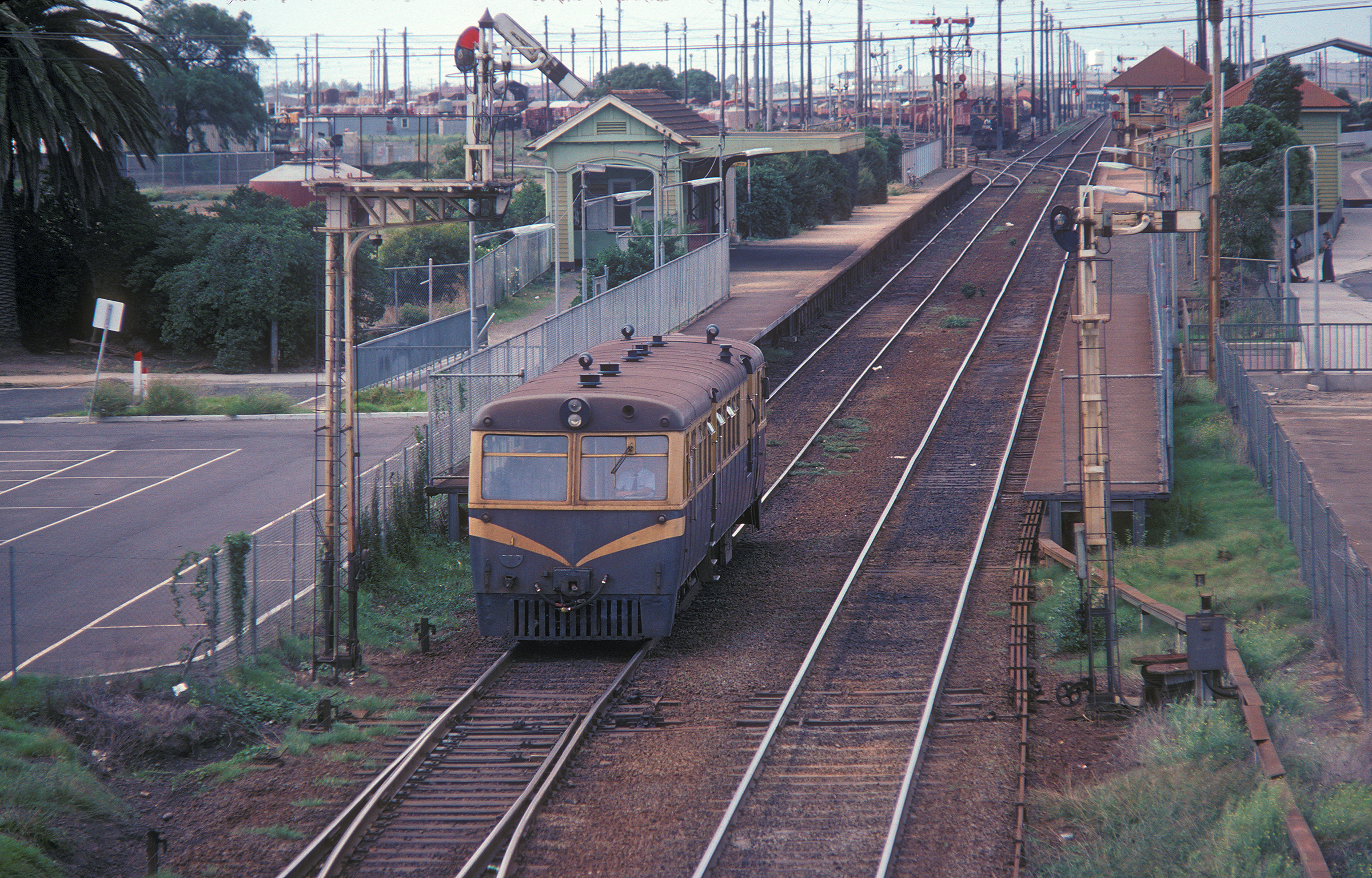
ABOVE: As best as I can ascertain, the start of the North Geelong to Warrenheip contract was at the turnout at the far (up) end of the up platform at North Geelong. Here we see RM 22 on a Ballarat to Geelong service departing North Geelong and about to diverge onto the down line from Melbourne. Feb 4 1978. (photo courtesy Geoff Winkler)
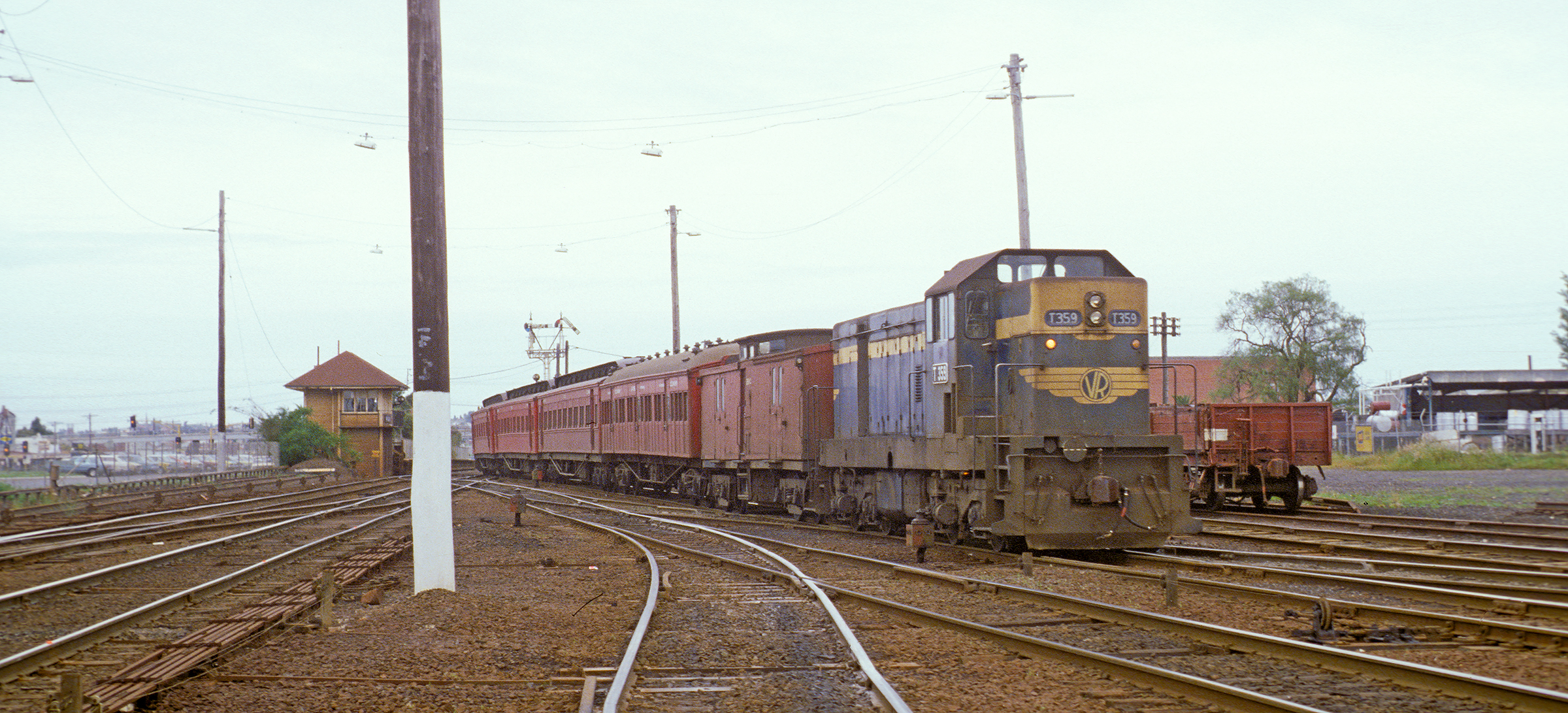
ABOVE: T 359 diverges away from the Melbourne line at North Geelong on its journey from Geelong to Ballarat, this service was normally a railmotor, Nov 9 1978. (photo courtesy Geoff Winkler)
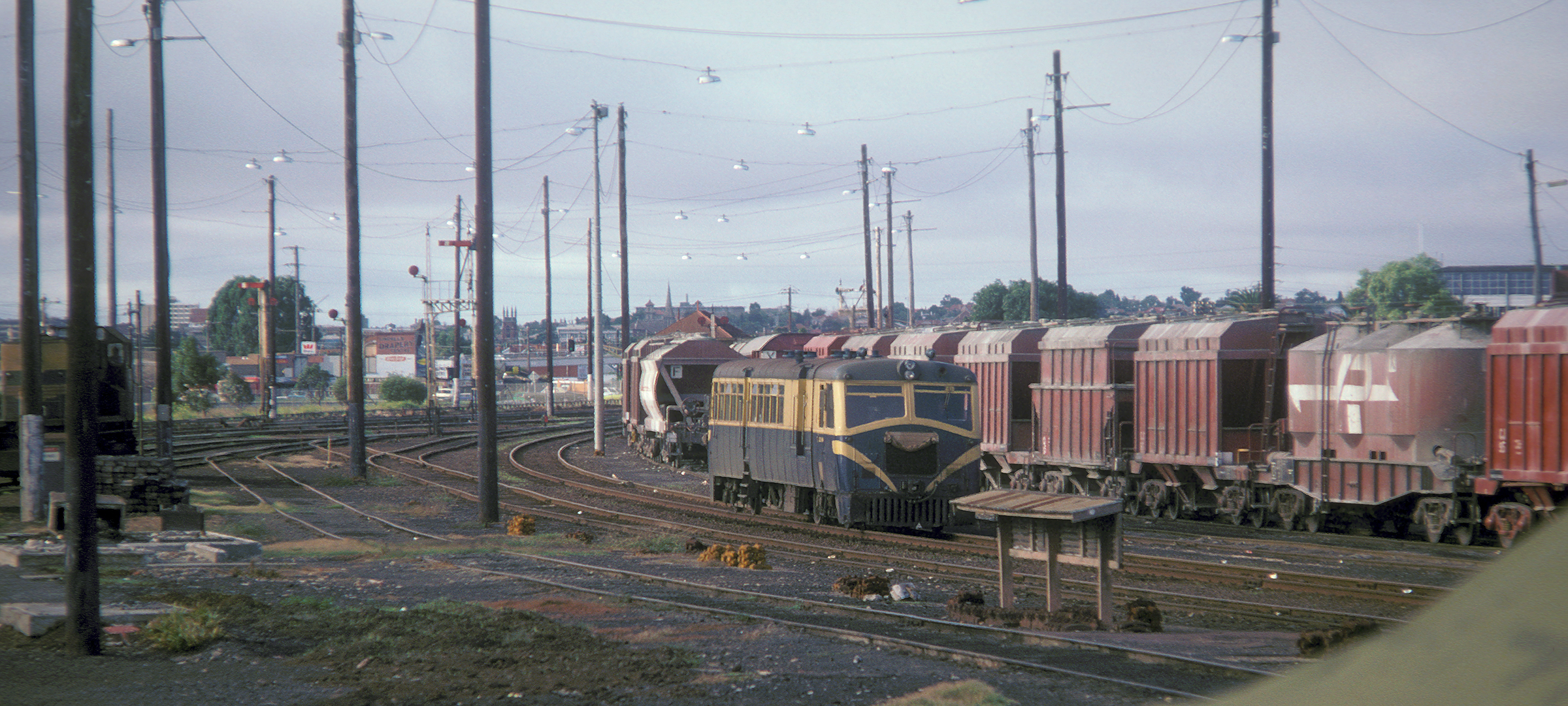
ABOVE: RM 22 departs North Geelong on its way to Ballarat, Nov 9 1979. (photo courtesy Geoff Winkler)
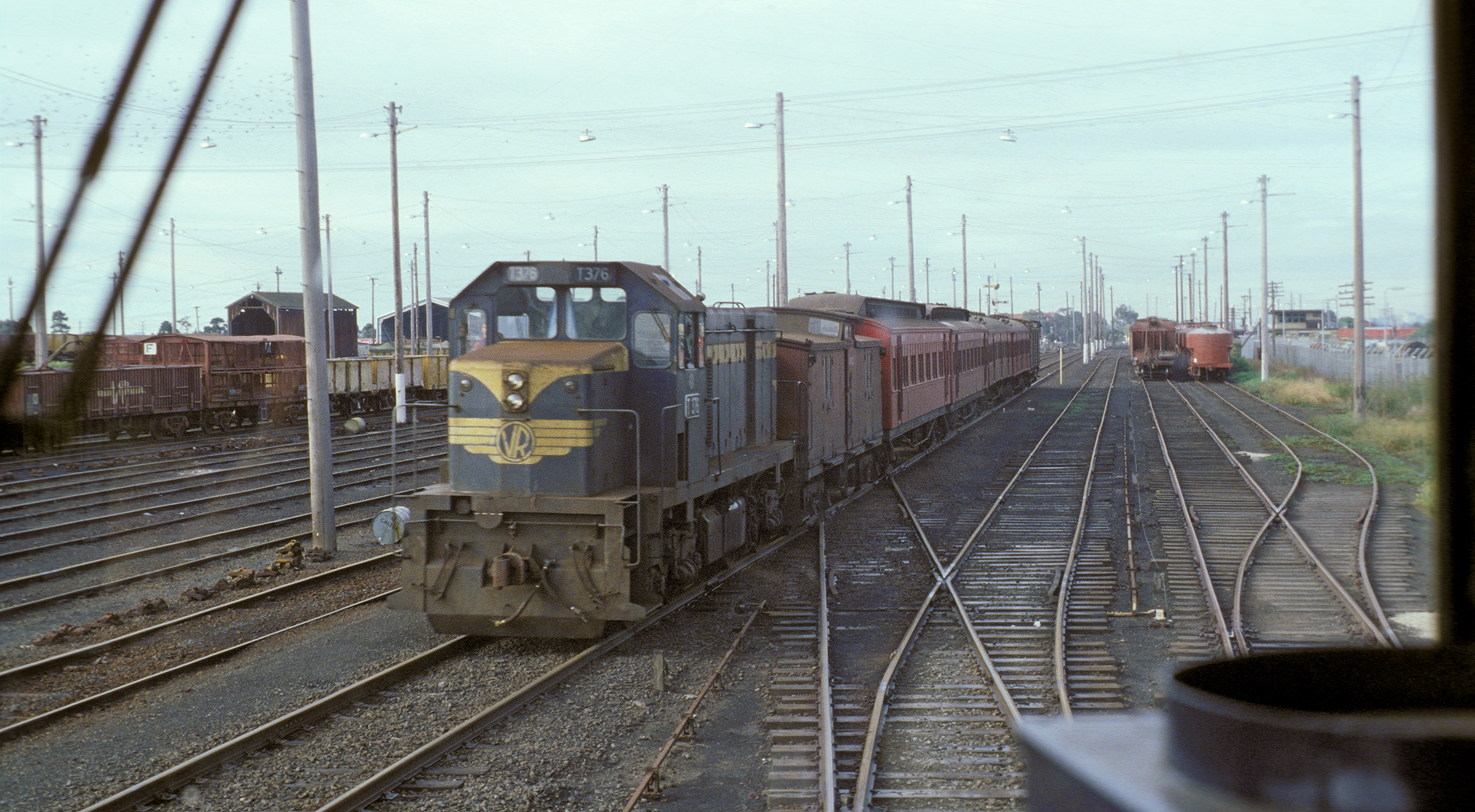
ABOVE: T 376 replaces a railmotor on a Geelong to Ballarat service as it passes the extensive and always busy North Geelong yard, photographed from the cab on an up Fyansford pilot, Apr 11 1978. (photo courtesy Geoff Winkler)
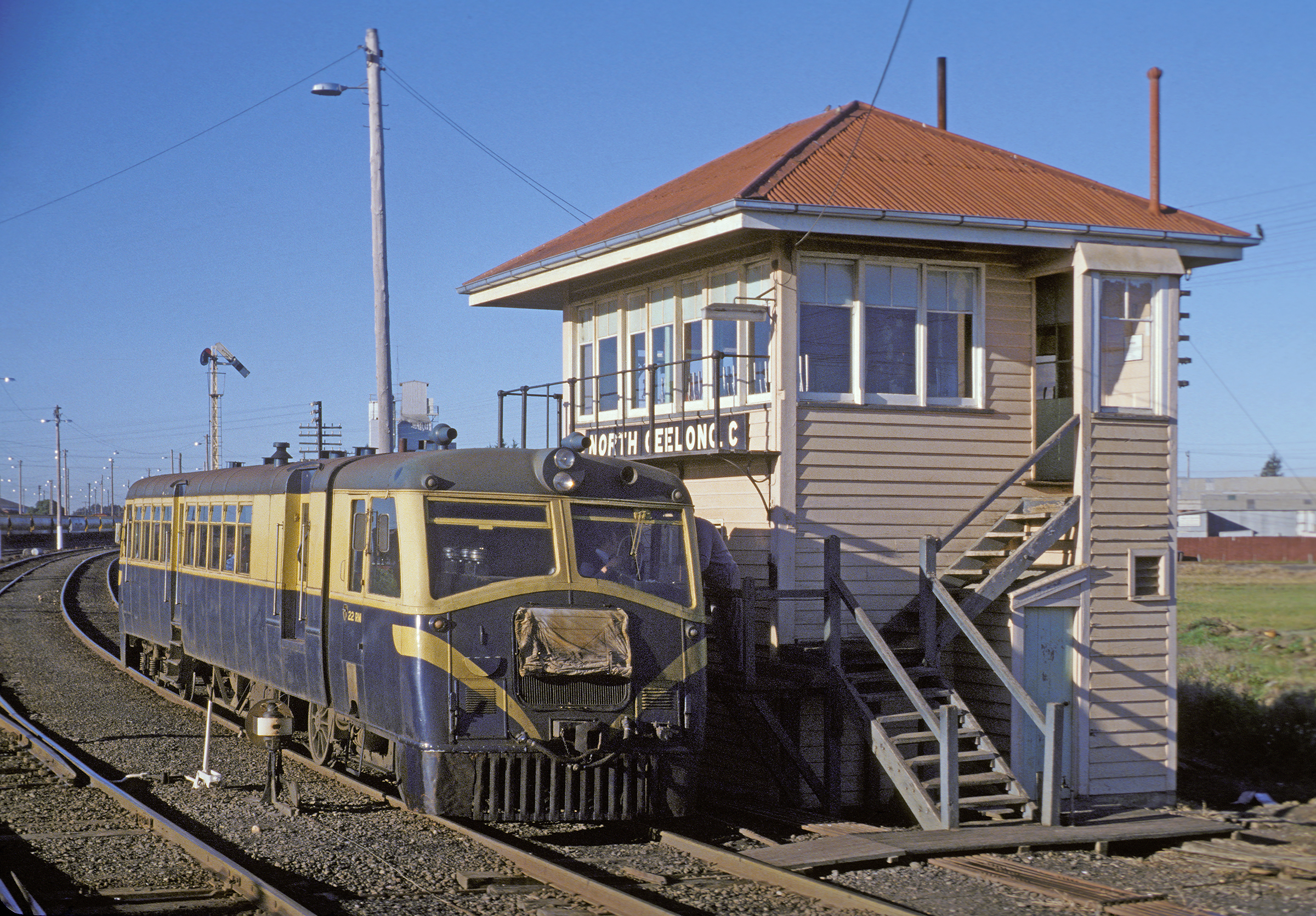
ABOVE: RM 22 pauses at North Geelong C box to exchange staffs on its journey to Ballarat, July 27 1978. (photo courtesy Geoff Winkler)

ABOVE: Photographed from Nth Geelong C signalbox we see T 333 arriving back at North Geelong on a Plant train. July 2 1978. (photo courtesy Geoff Winkler)
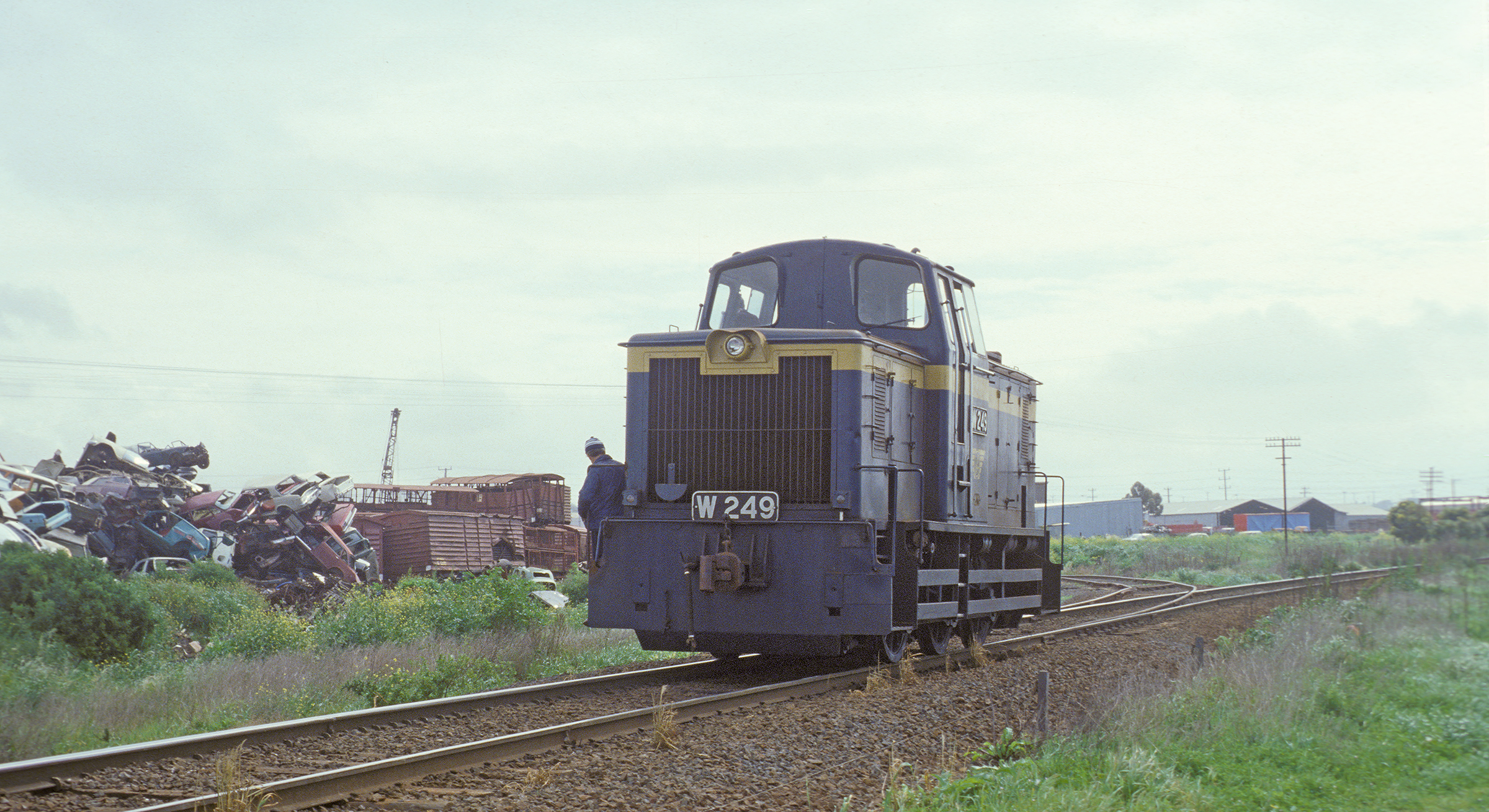
ABOVE: W 249 enters the mainline from the Simsmetal siding which was situated about 250 metres outside the home arrival signal for North Geelong C, Sep 19 1978. (photo courtesy Geoff Winkler)
BELOW: A shunter operates the staff locked points to the Simsmetal siding after W 250 has placed some wagons there for scrapping, Sep 20 1978. (photo courtesy Geoff Winkler)
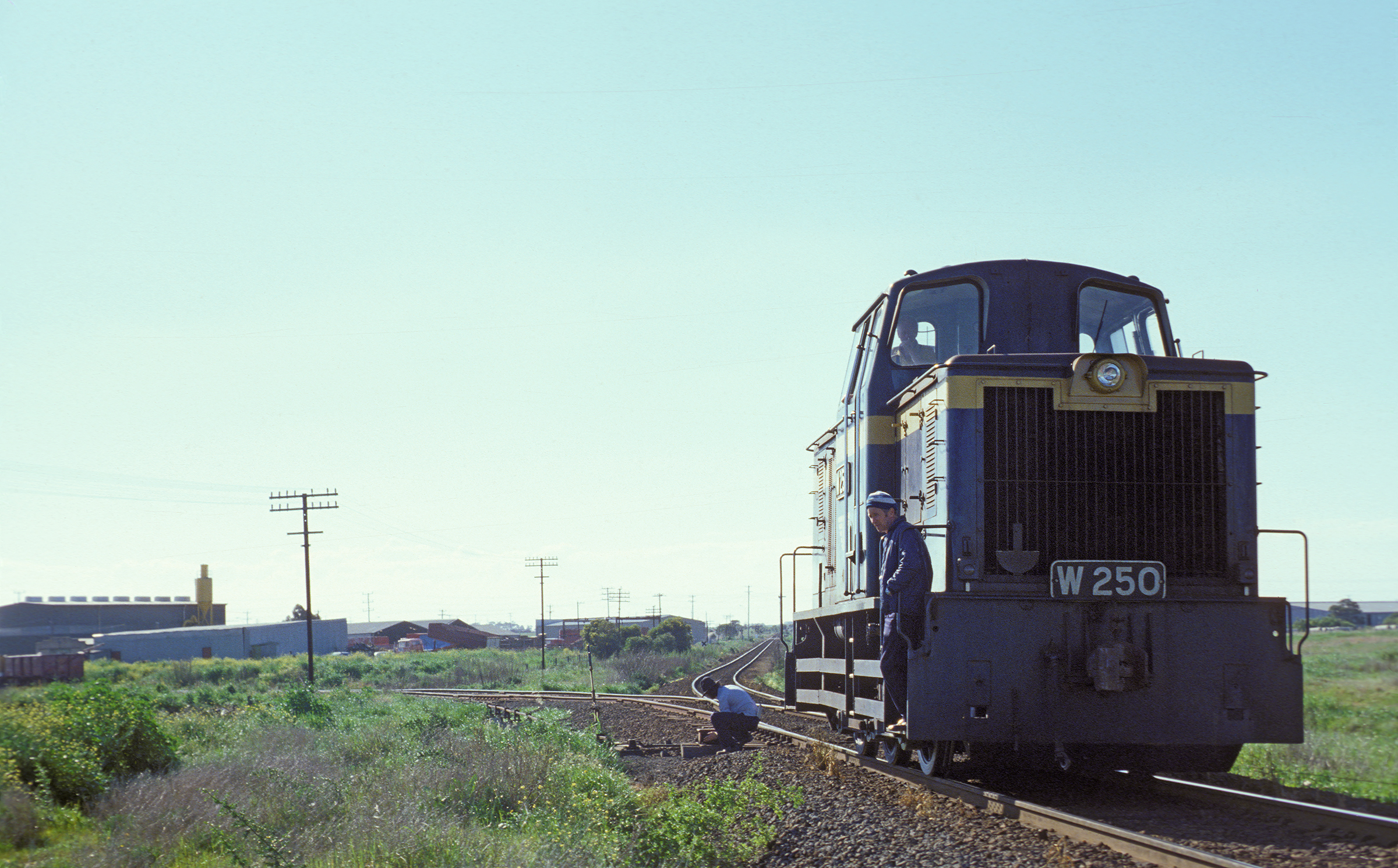
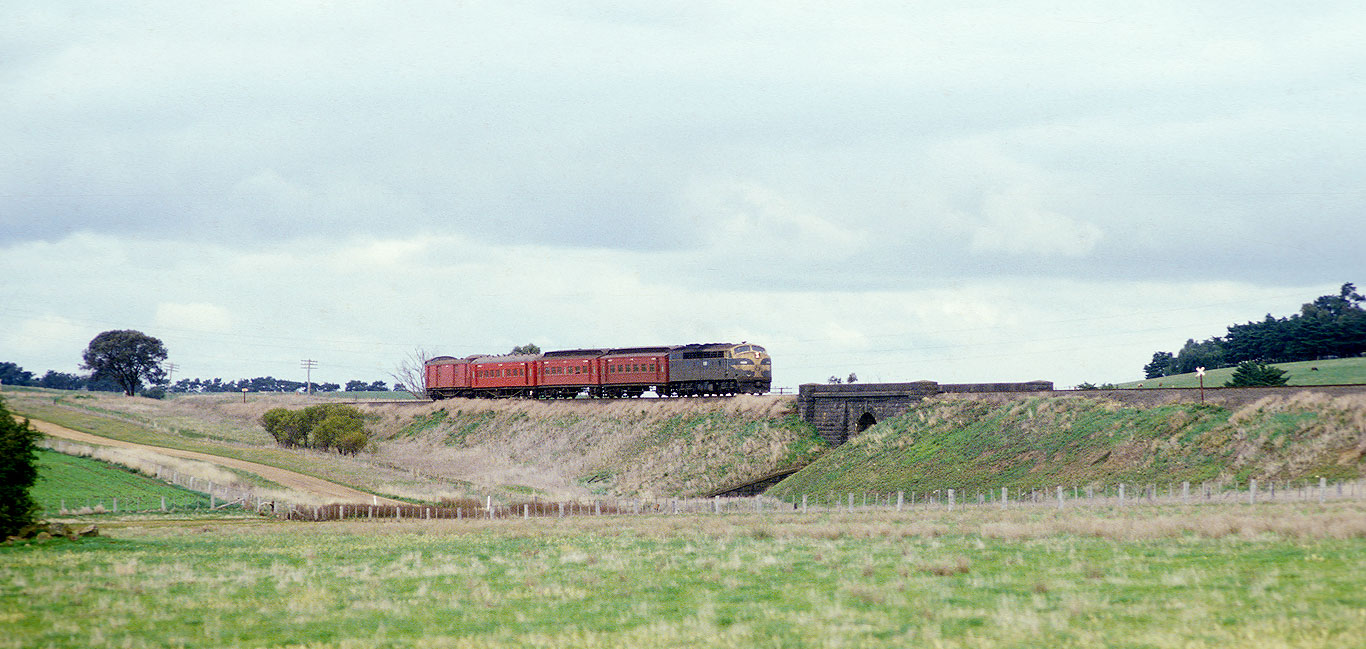
ABOVE: A down pass approaches the bridge over the upper reaches of Cowies Creek as it nears Moorabool. Sept. 12 1979. (photo courtesy Geoff Winkler)
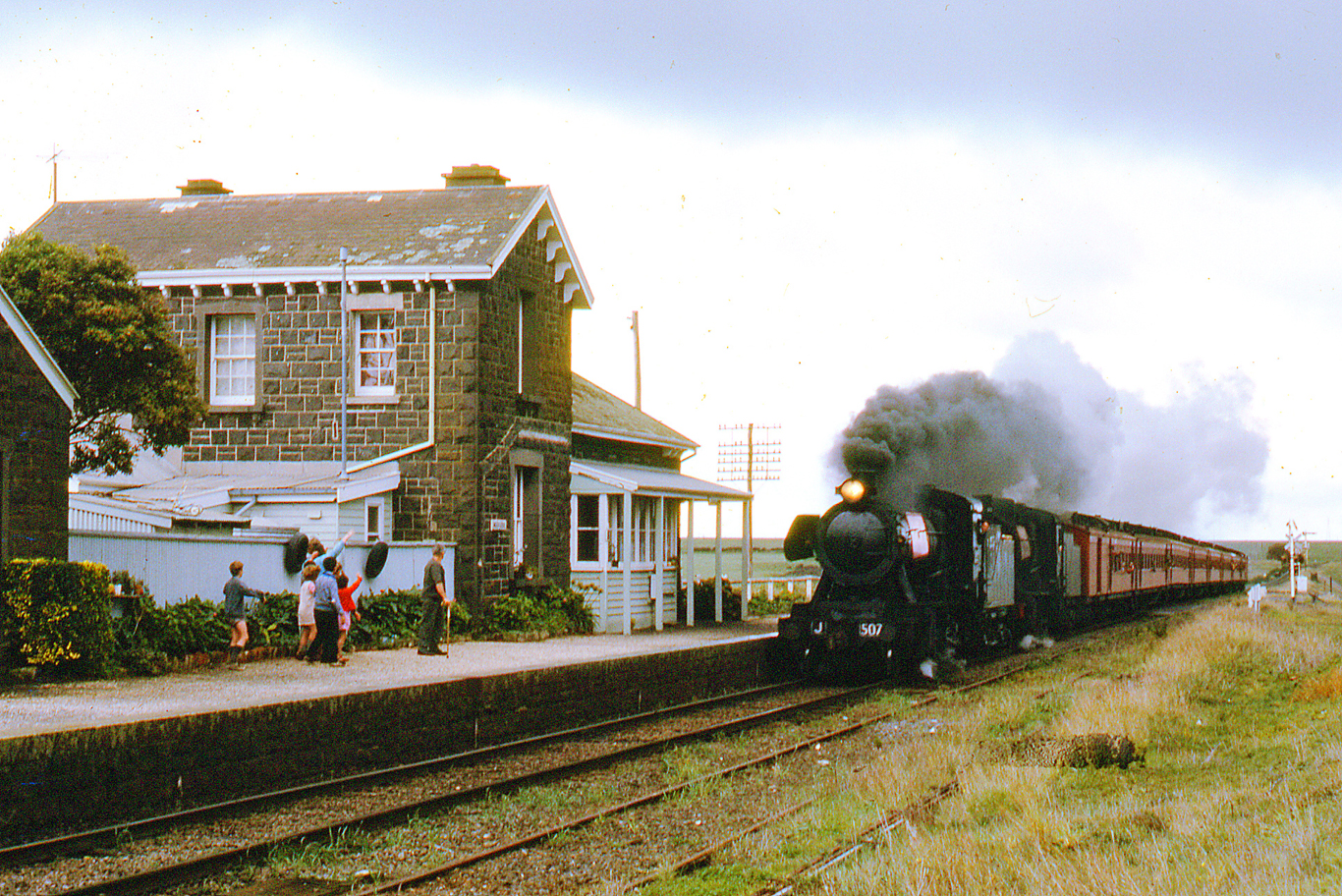
ABOVE: Double J Class passing through Moorabool towards Ballarat on 23 May 1970. The signals are all intact and the station was manned at this time. (photo courtesy Neville Gee)

ABOVE: The Vintage Train hauled by R 707 gets 'right of way' from the guard to depart Moorabool from on 4 October 1970. (photo courtesy Neville Gee)
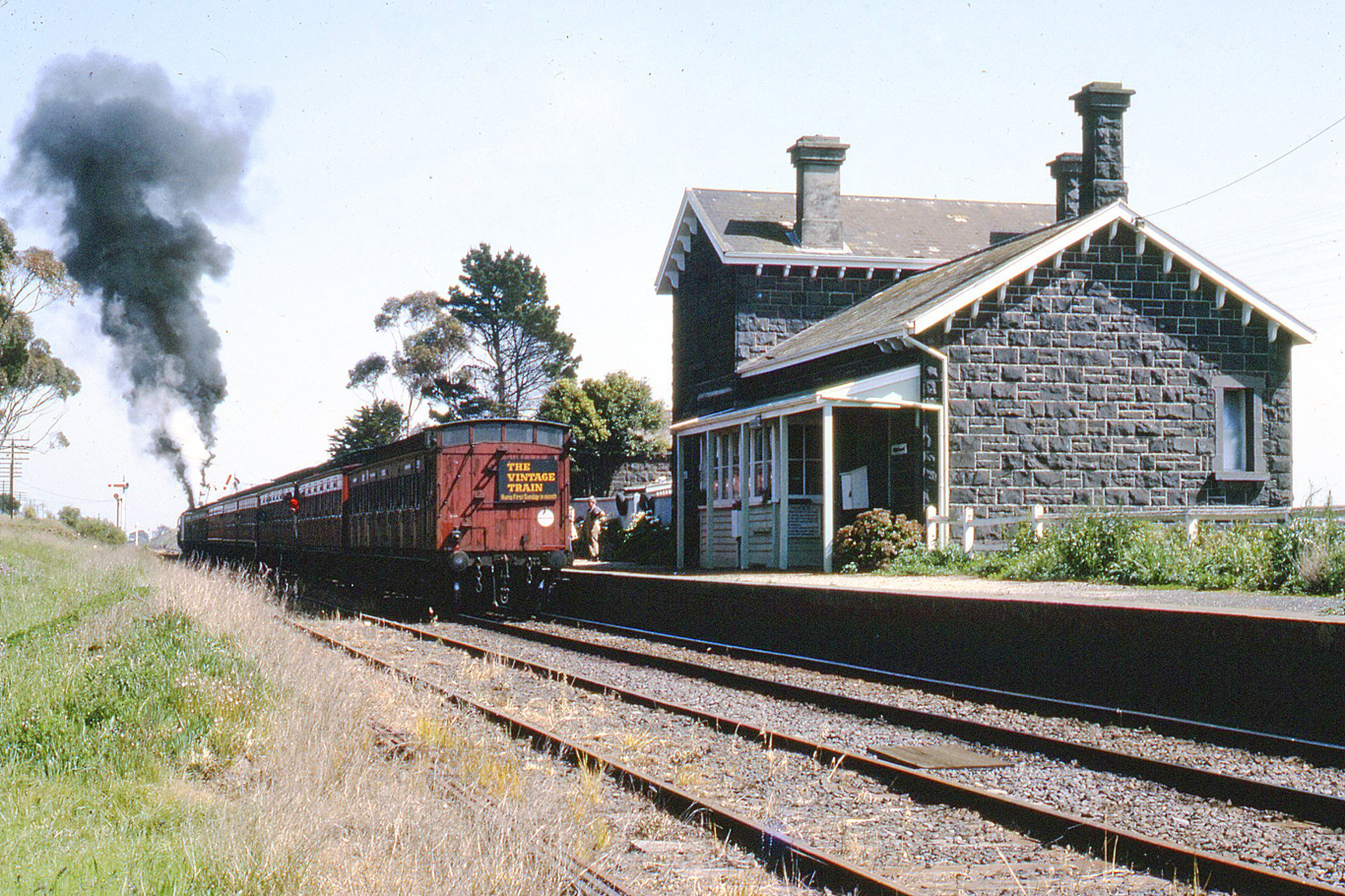
ABOVE: With a full head of steam and blowing off, R 707 lifts the seven car Vintage Train away from Moorabool on 4 October 1970. (photo courtesy Neville Gee)
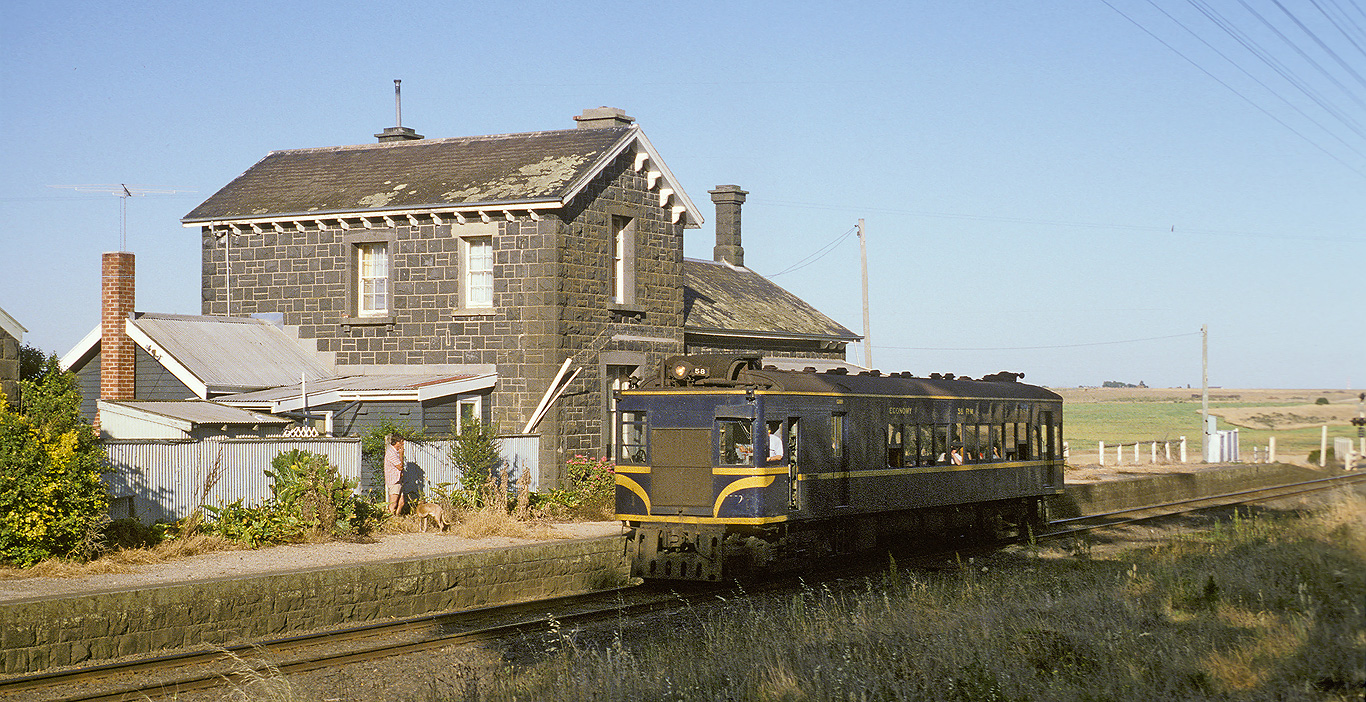
ABOVE: A down DERM on a railfan special pauses at Moorabool, Nov 30 1979. (photo courtesy Geoff Winkler)
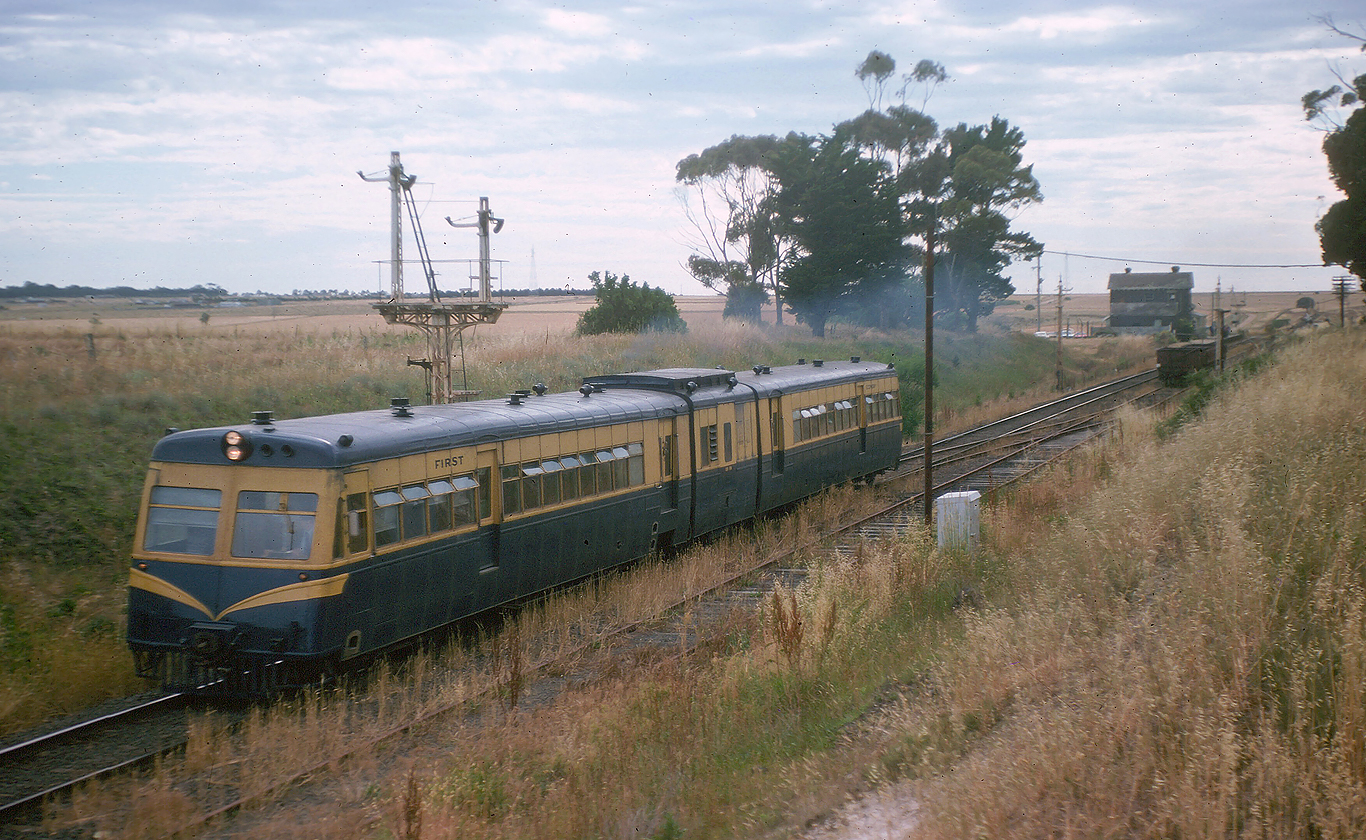
ABOVE: A 280 Walker departs Moorabool on a down Ballarat service and BELOW: A down goods on the same day, Dec 21 1976, the day Moorabool lost its signals and was dis-established as an electric staff station. (both photos courtesy David Hewitt)
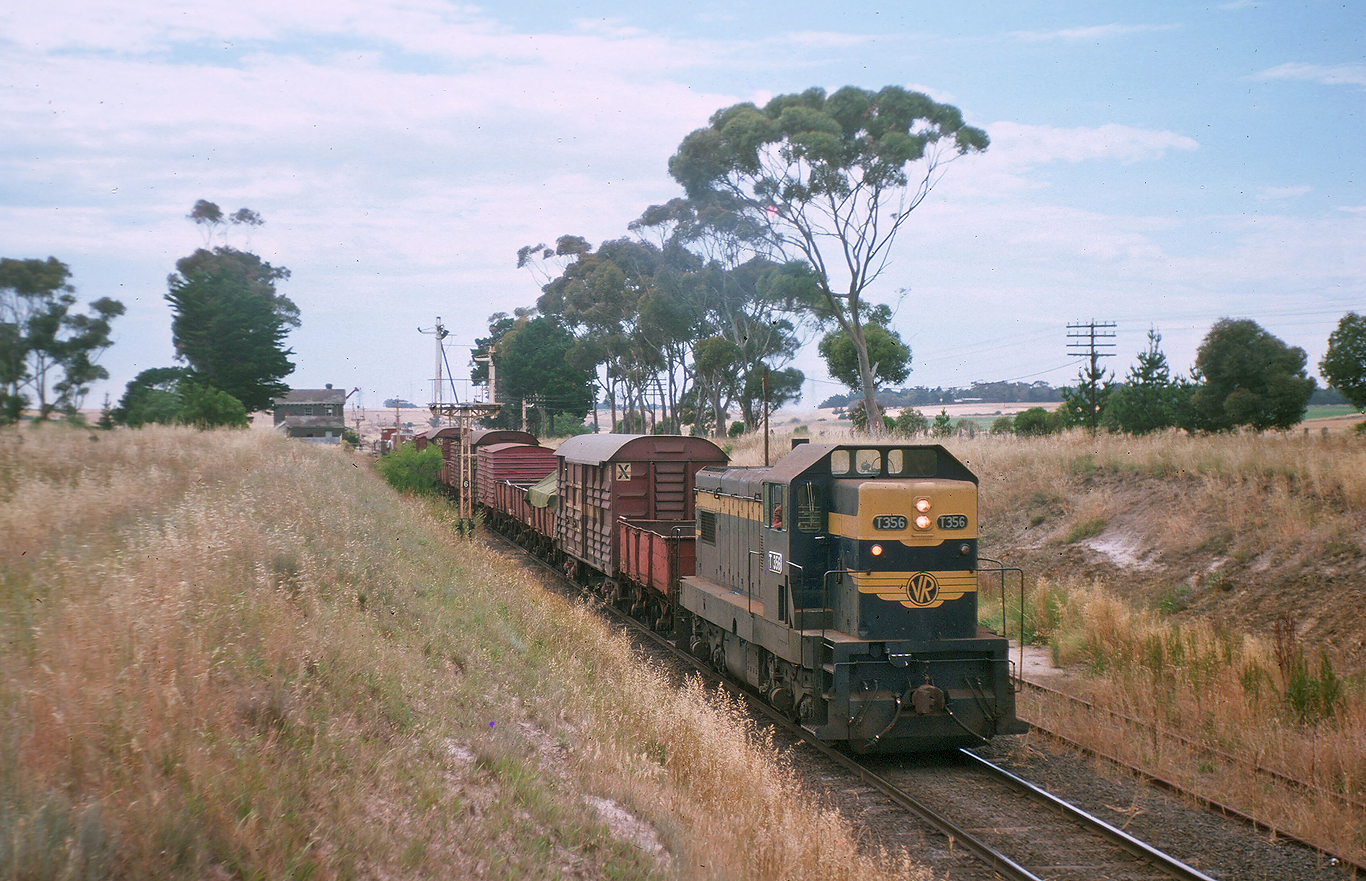
During the work to strengthen the Moorabook viaduct a signalbox and works sidings were constructed. Moorabool viaduct signal diagram 24-1916
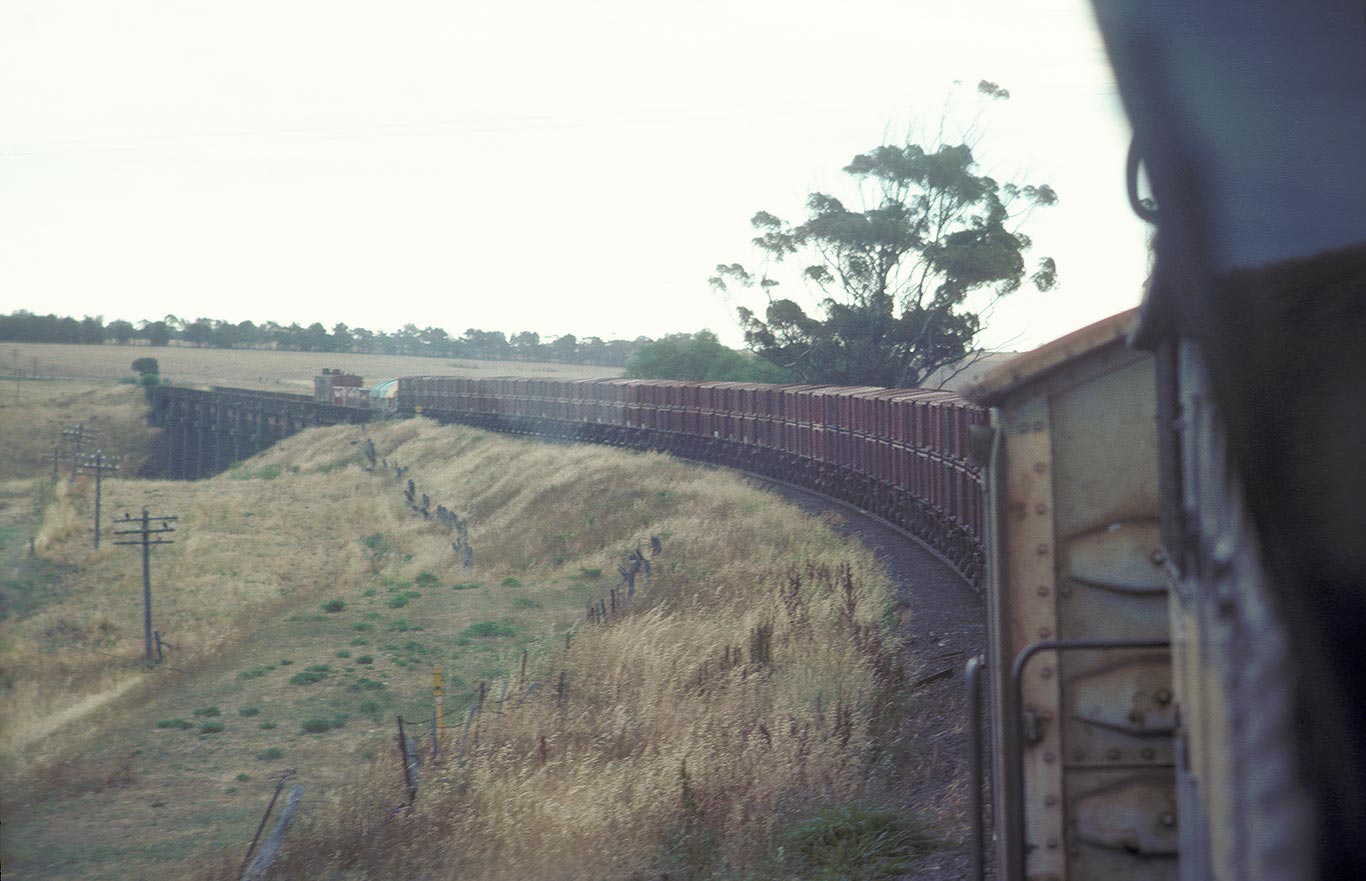
ABOVE: The view from X 53 on an up goods consisting of mainly livestock wagons, with the Moorabool viaduct in the background. Dec 20 1977. (photo courtesy Geoff Winkler)
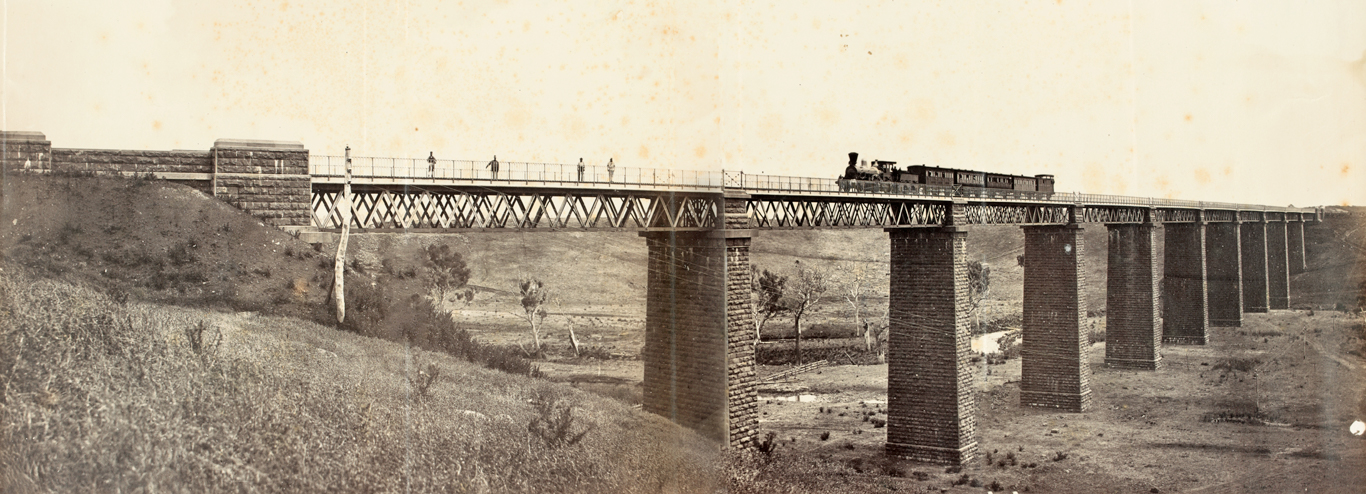
ABOVE & BELOW: Without a doubt the engineering highlight of the Nth Geelong to Warrenheip line is the viaduct over the Moorabool river. These two photos show the viaduct as originally built in 1862. By 1894 the double track was abolished between Moorabool and Gheringhap "due to the weakness of girders" and speed over the viaduct was limited to 15 MPH. In 1916 work commenced to install new steel piers in between the bluestone piers and new girders installed.
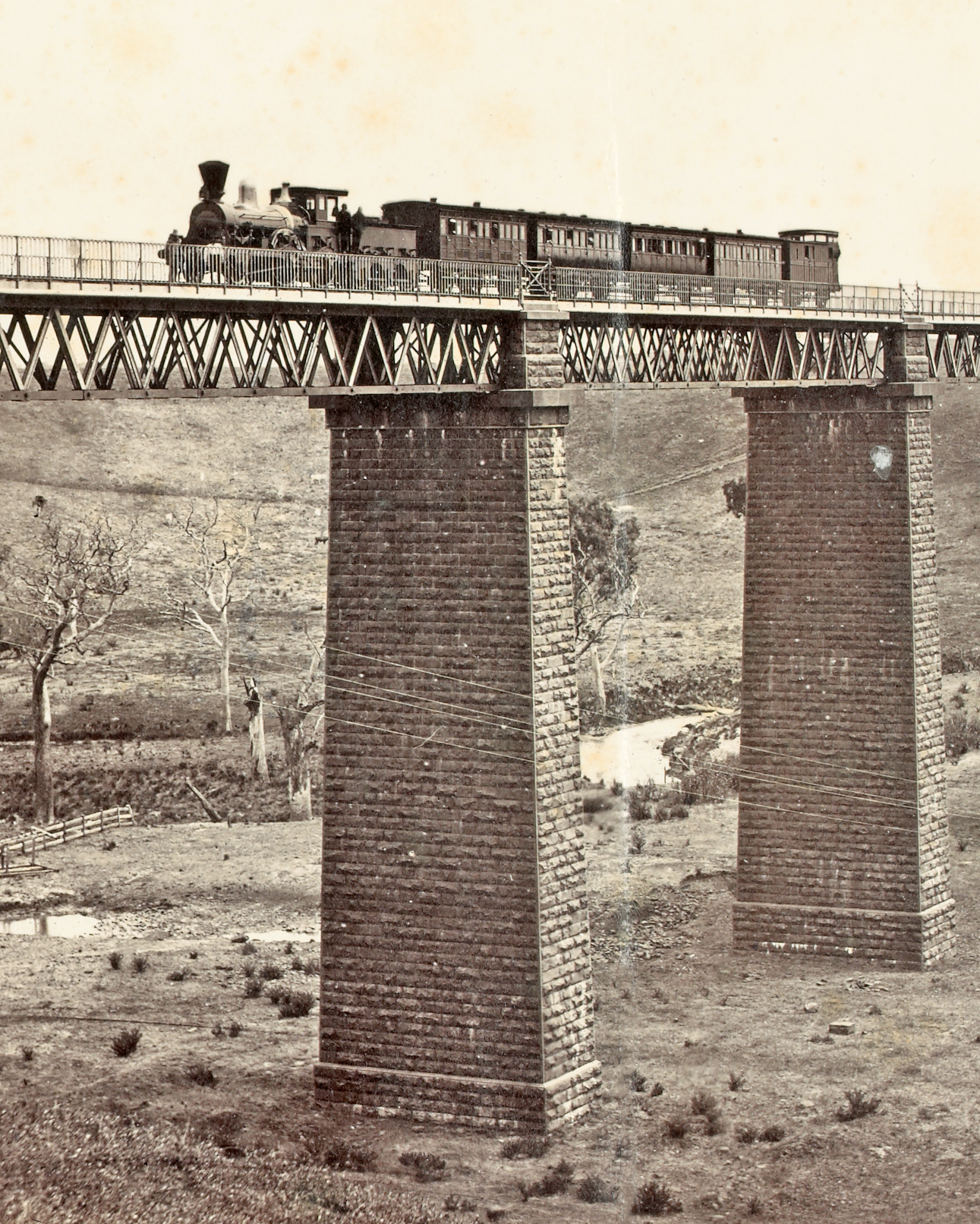
BELOW: The viaduct post 1916 when the new steel piers were added.
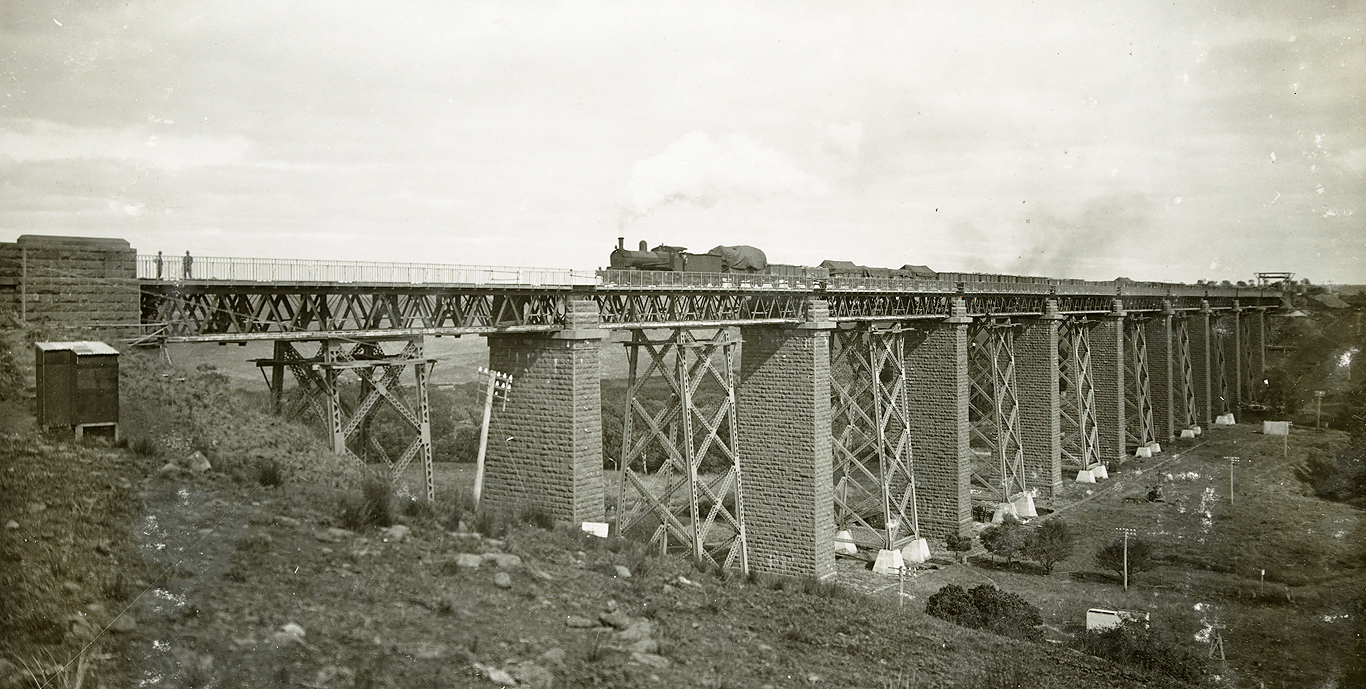
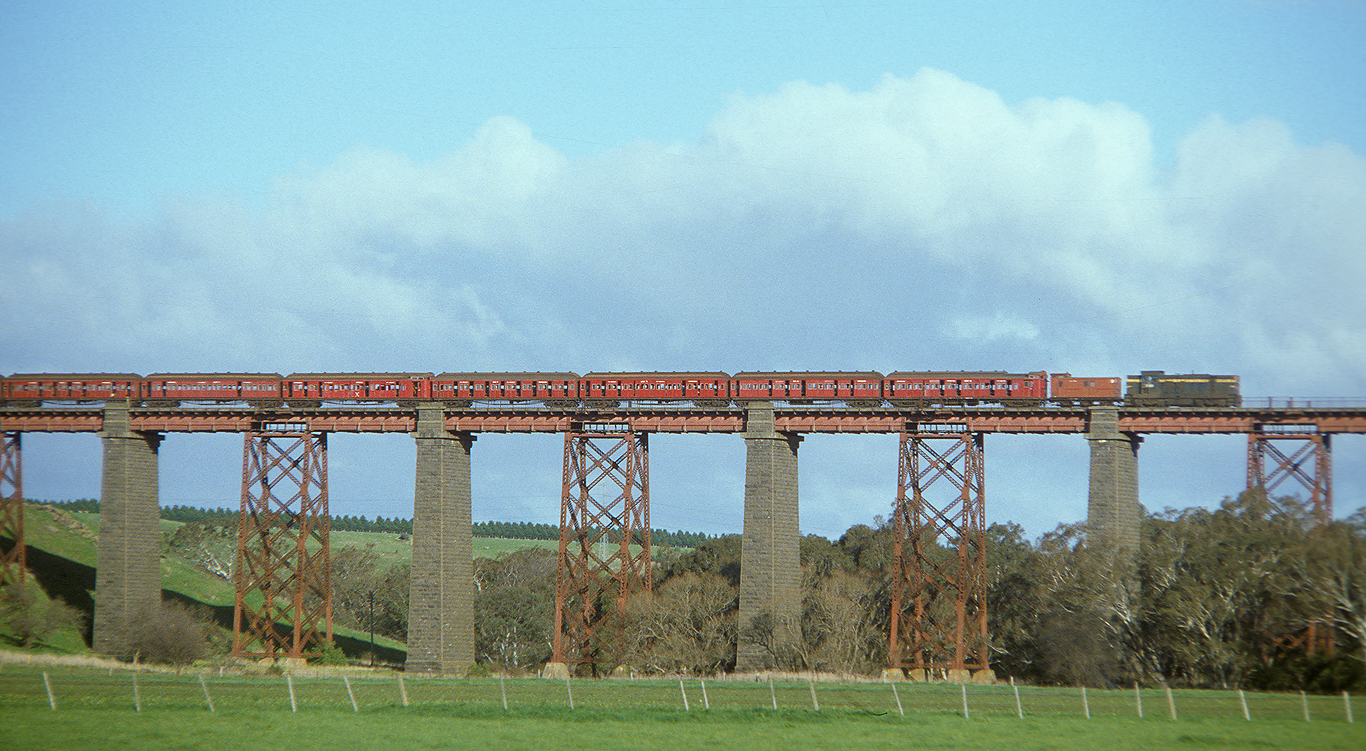
ABOVE: T 359 hauls a rake of Tait carriages across the viaduct on July 11 1978 on their way to Allendale for scrapping. (photo courtesy Geoff Winkler)

ABOVE: X 44 on the down 8.30am Spencer Street to Horsham pass. This train normally ran via Bacchus Marsh. The first 4 cars are the normal train, the two rear blue steel cars look to be the Governors cars on a inspection trip. Aug 29 1979. (photo courtesy Geoff Winkler)
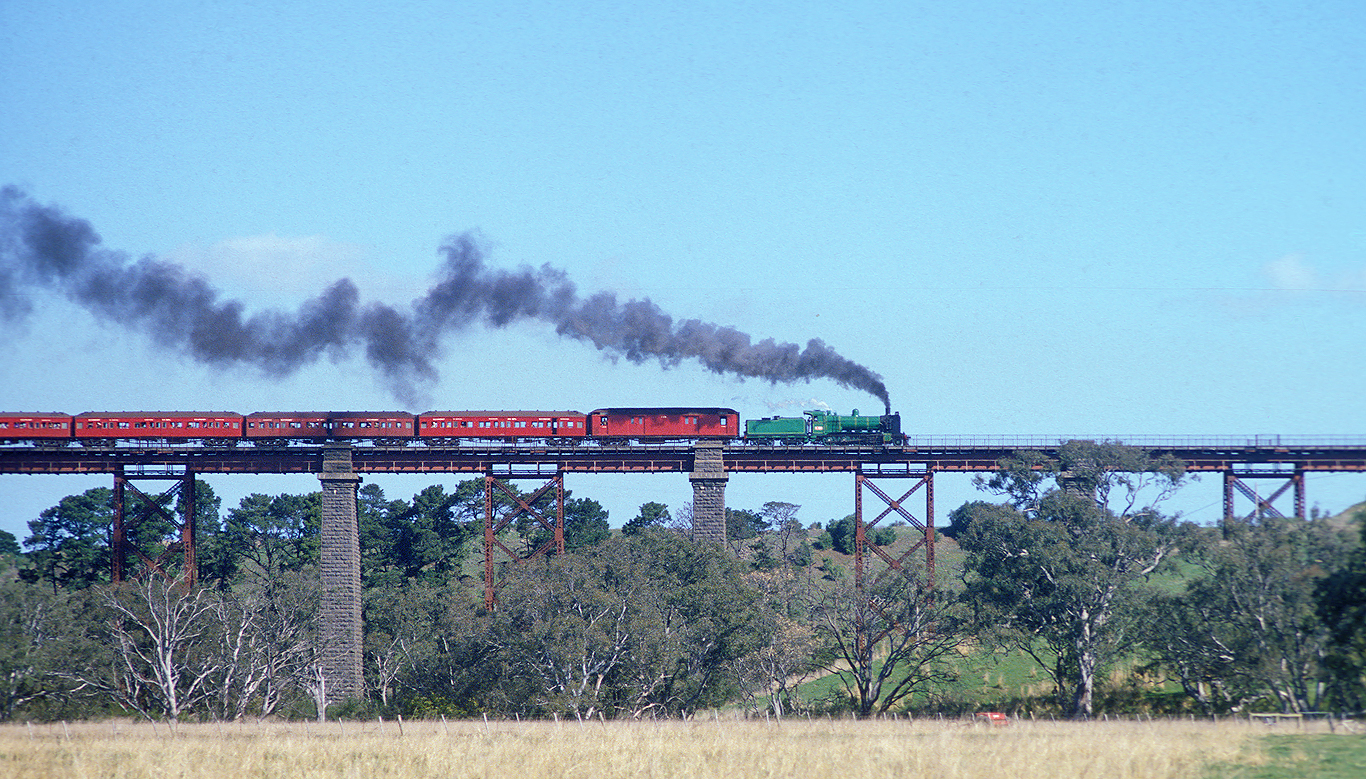
ABOVE: K 190 on a down enthusiast special, Sep 23 1979. This may have been K 190's first run in its unique, and unprototypical, green paint scheme. (photo courtesy Geoff Winkler)
FOR PHOTOS OF GHERINGHAP, SEE THE GHERINGHAP TO MAROONA PAGE.
1907 Bannockburn signal diagram
1934 Bannockburn signal diagram
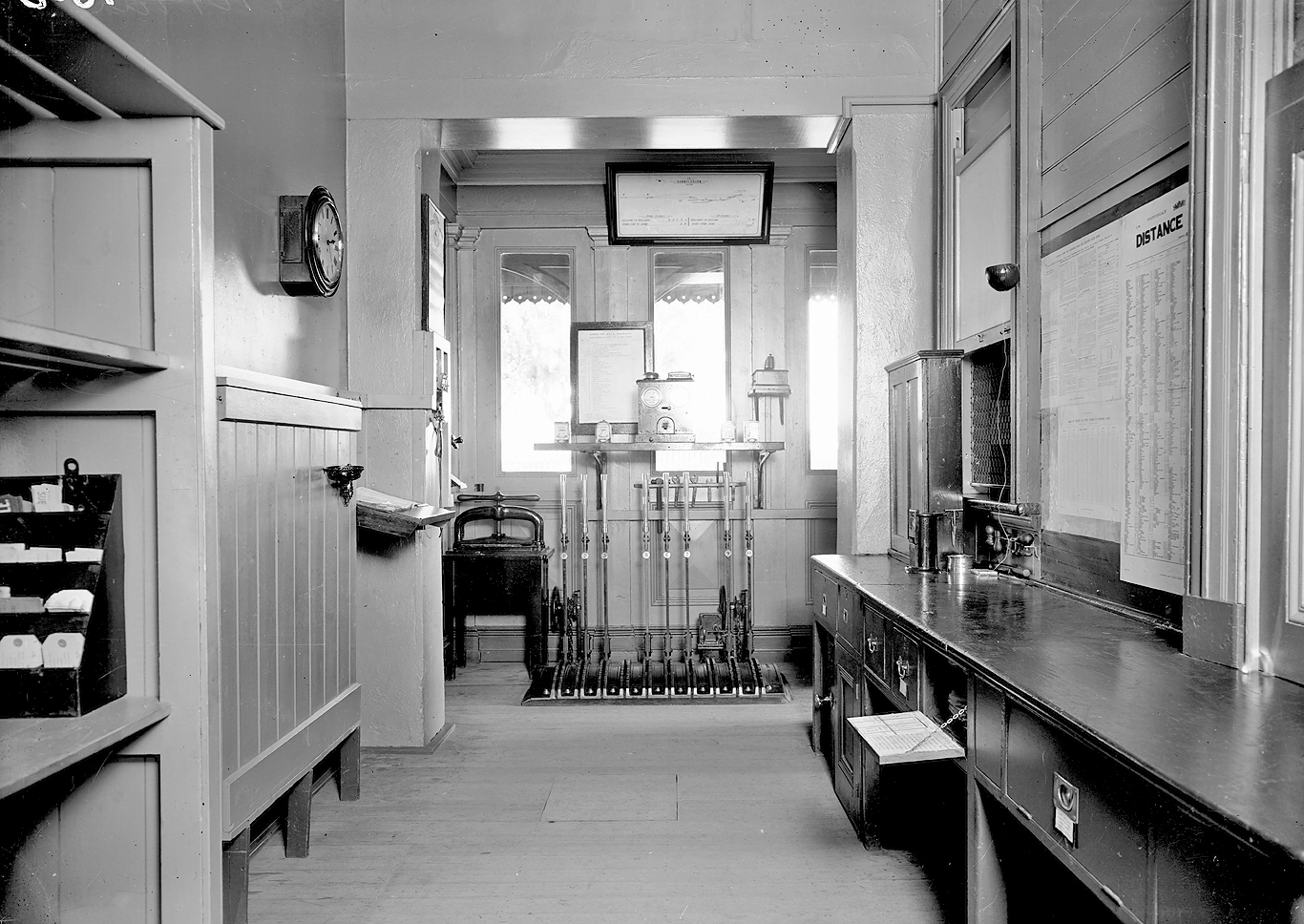
ABOVE: The signal bay at Bannockburn. This 10 lever frame (8 working) was installed in 1907 when the down line to Gheringhap was abolished, as shown here double line block working was still in use to Lethbridge. The photo was taken before June 1934 at which time this frame was abolished and replaced by a double wire frame due to the down line to Lethbridge being abolished, at this time it became an electric staff crossing station. On June 29 1956 it was dis-established as an electric staff station and the crossing loop was removed.(official VR photo)
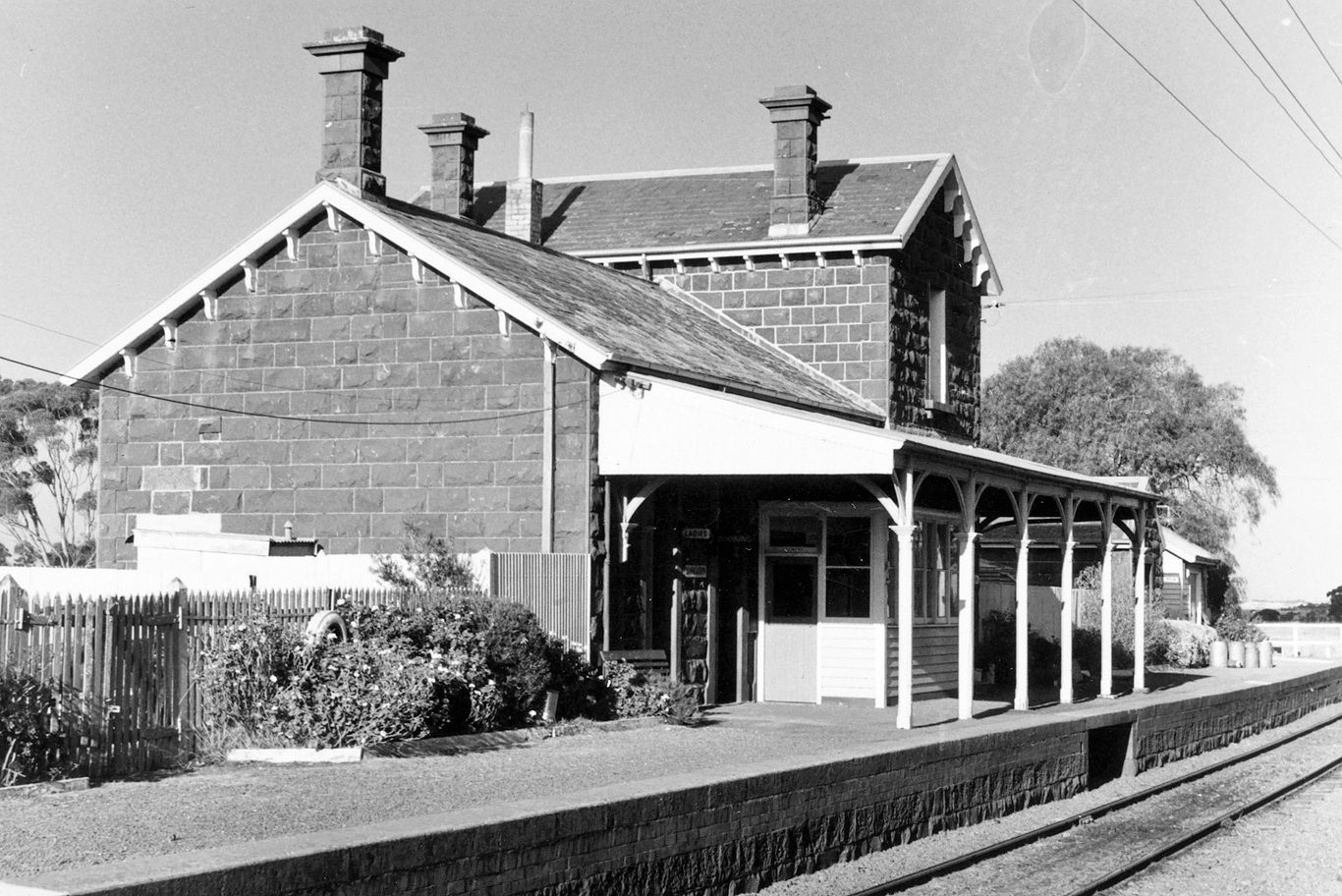
ABOVE: Bannockburn 1976. Bannockburn was originally known as "Leigh Road" and renamed Nov 21 1904. The section from Gheringhap to Bannockburn was single tracked (down line removed) in 1907. The section from Bannockburn to Lethbridge was single tracked in 1934. In 1956 it lost all of its signals and was no longer an electric staff station. (Photo courtesy State Library Victoria)
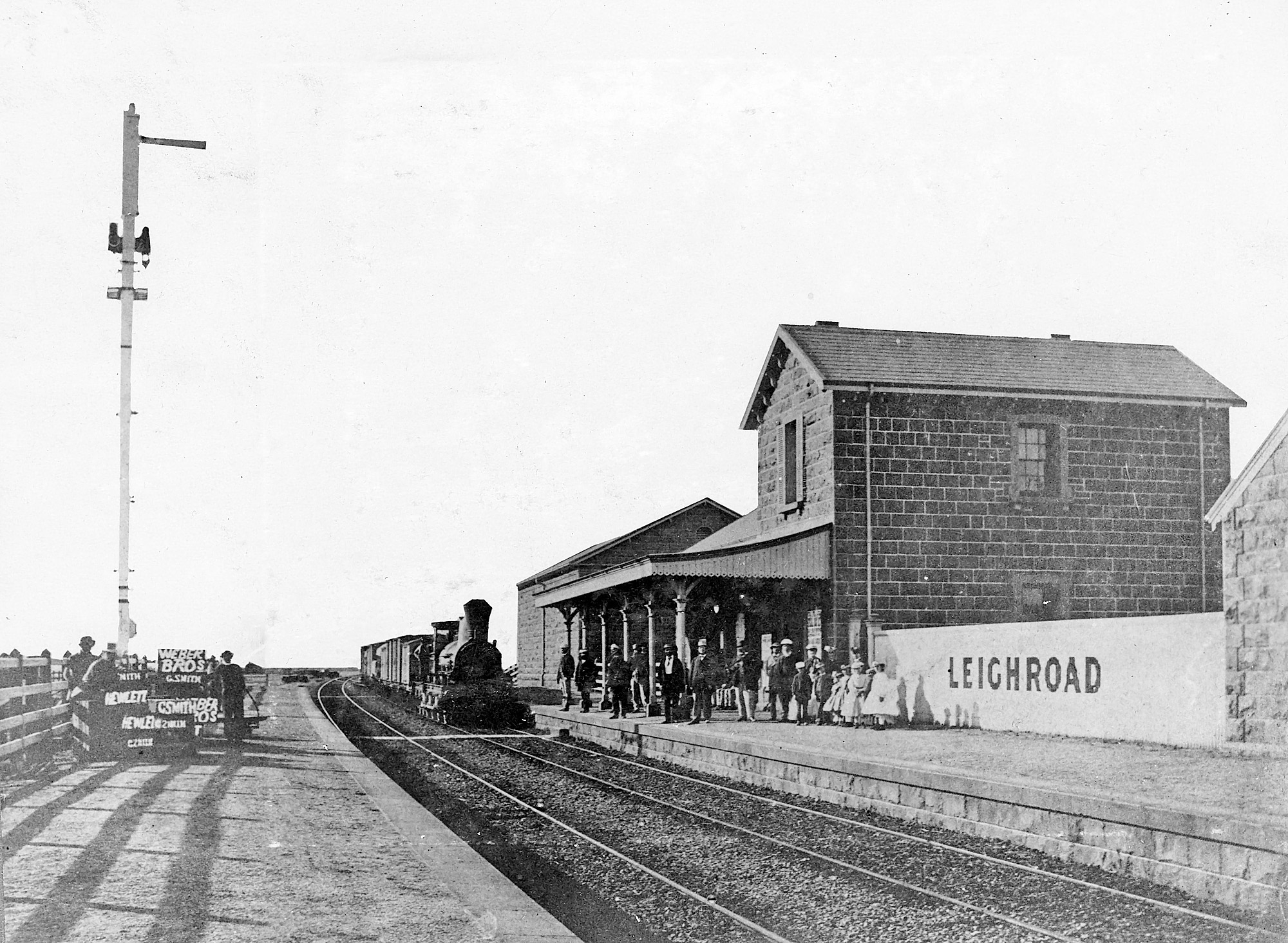
ABOVE: An up train at Leigh Road, later renamed Bannockburn, not long after the line was opened. (Madden collection, SLV)
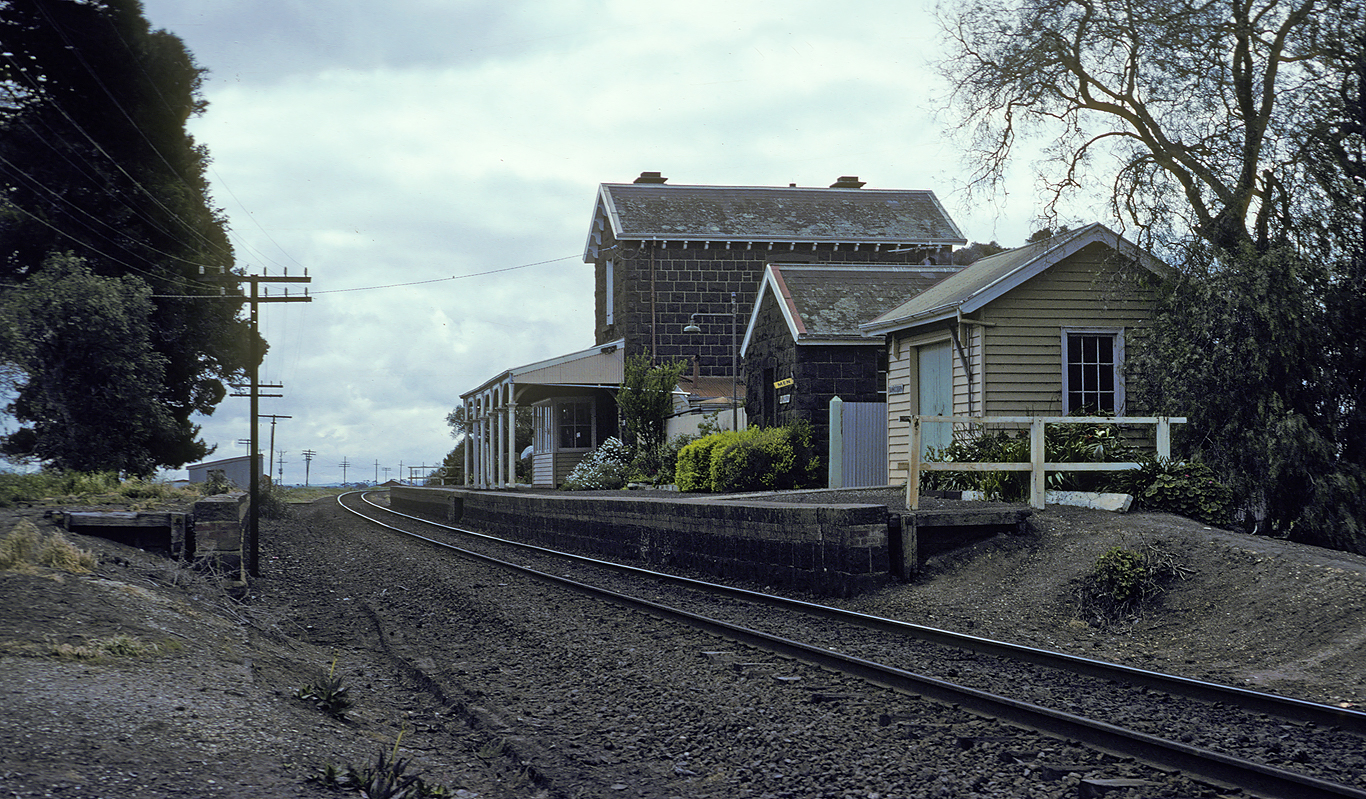
ABOVE: Bannockburn viewed from the Geelong end. Note the remains of the original down platform. Sep 28 1981.
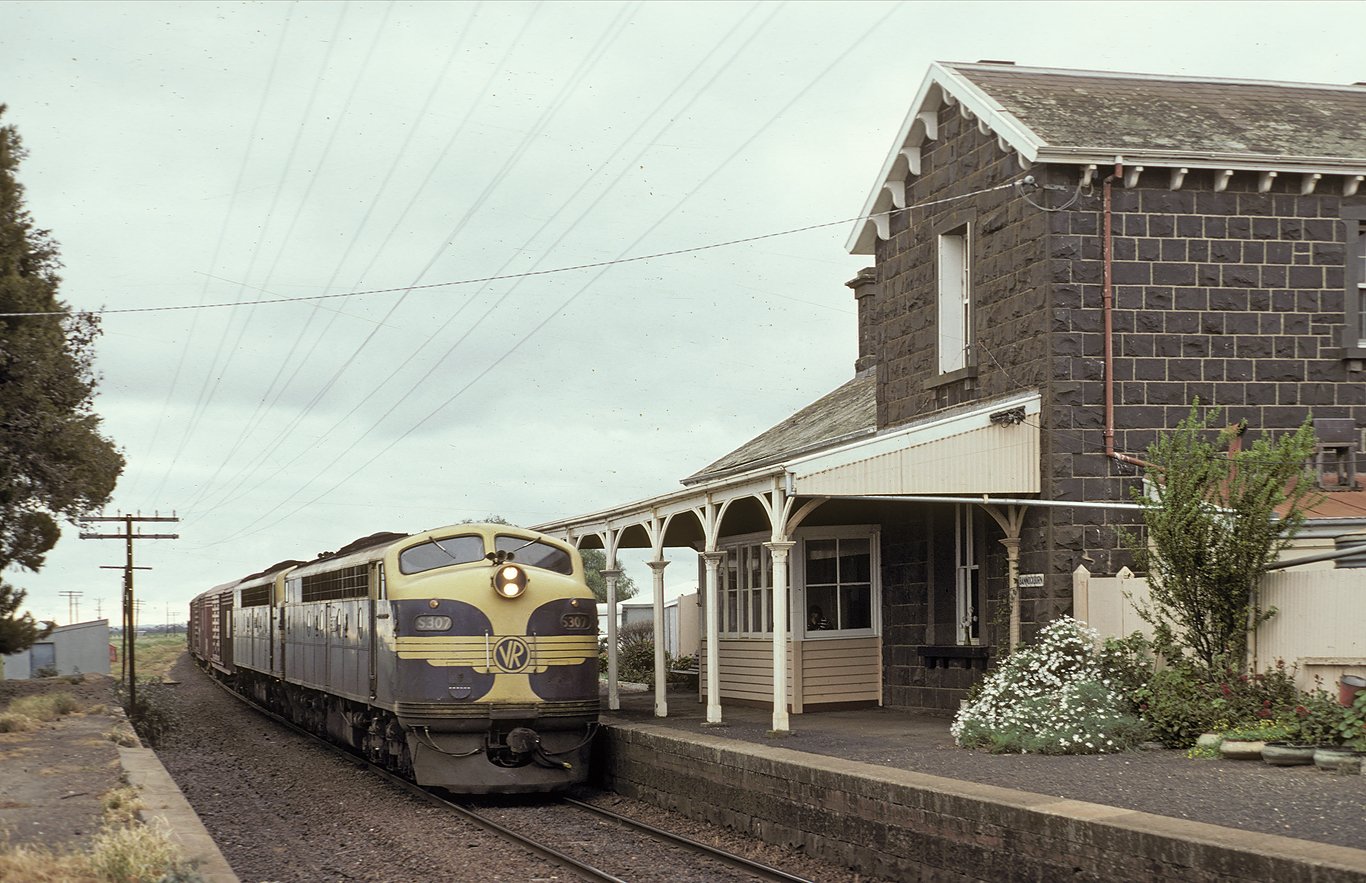
ABOVE: S 307 and 305 on #9144 up interstate express goods at Bannockburn. Sep 28 1981.

ABOVE: A "Geelong water train" at Bannockburn, Jan 8 1969. (official VR photo PR 2966)

ABOVE: T359 on a down Tait special to Kingston at Bannockburn. July 11, 1978. (photo courtesy Geoff Winkler)

ABOVE: S 310, T 354 & T 400 on a lengthy down goods, begin to gather a little more momentum as the grade slightly eases through Bannockburn. 14:32 on November 5, 1978. Note the timber goods platform in the left foreground & the bluestone one, poking out of the grass further on. (photo courtesy Geoff Winkler)
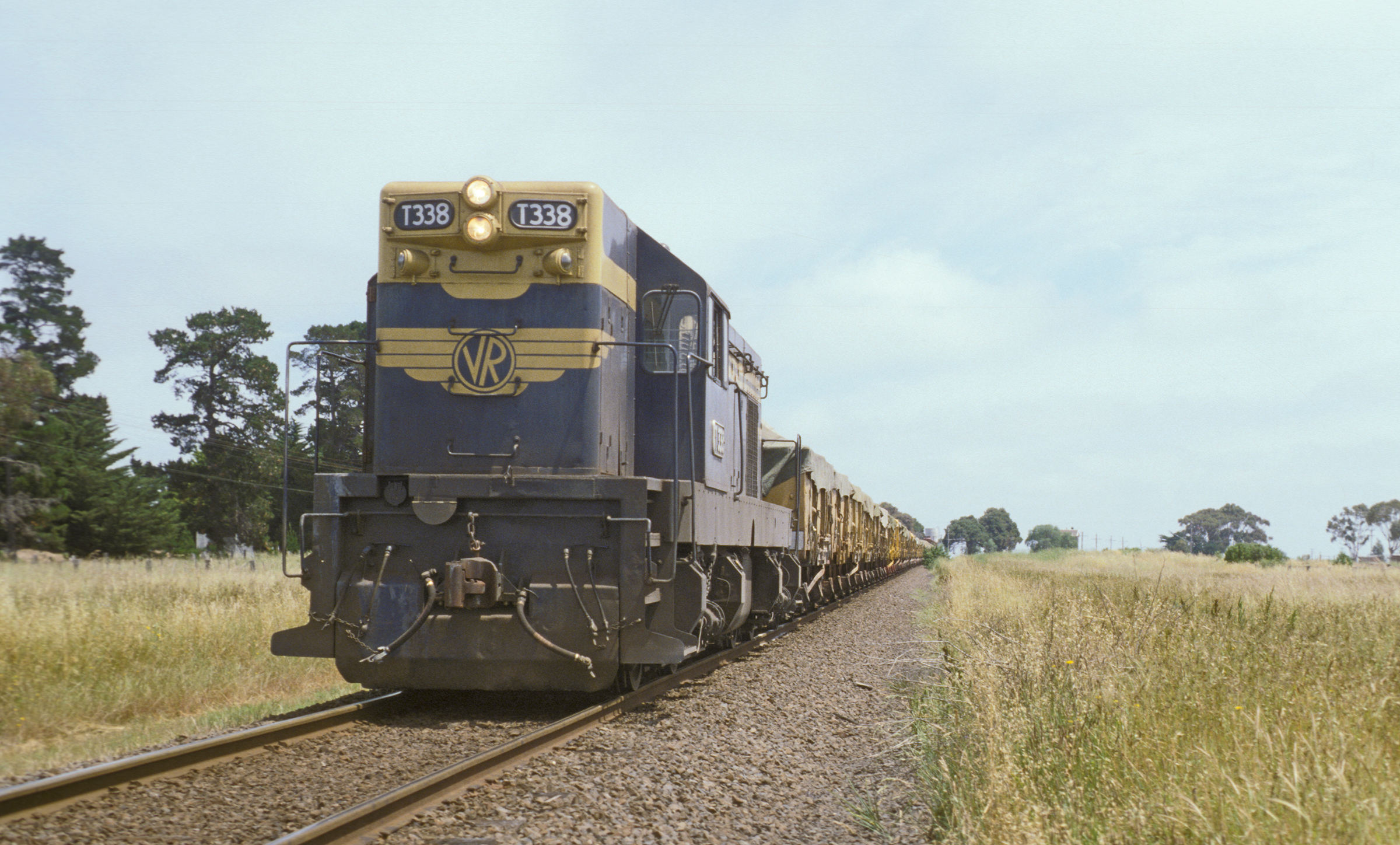
ABOVE: T 338 with an up goods, paused on the up side of the level crossing at Bannockburn. 12:05, November 28, 1978. (photo courtesy Geoff Winkler)
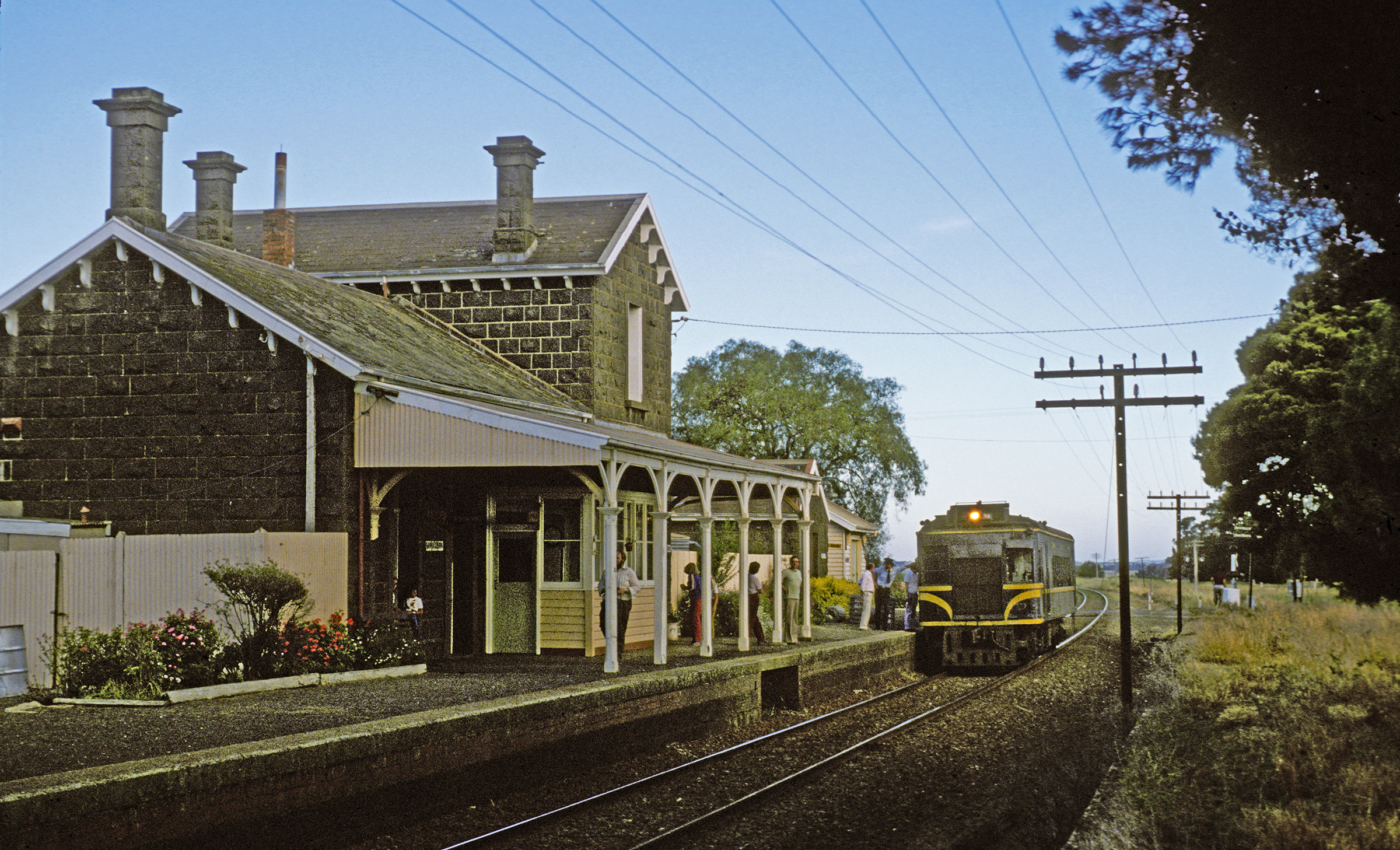
ABOVE:RM 58 on the down on a CMRC trip at Bannockburn November 30, 1979. (photo courtesy Geoff Winkler)
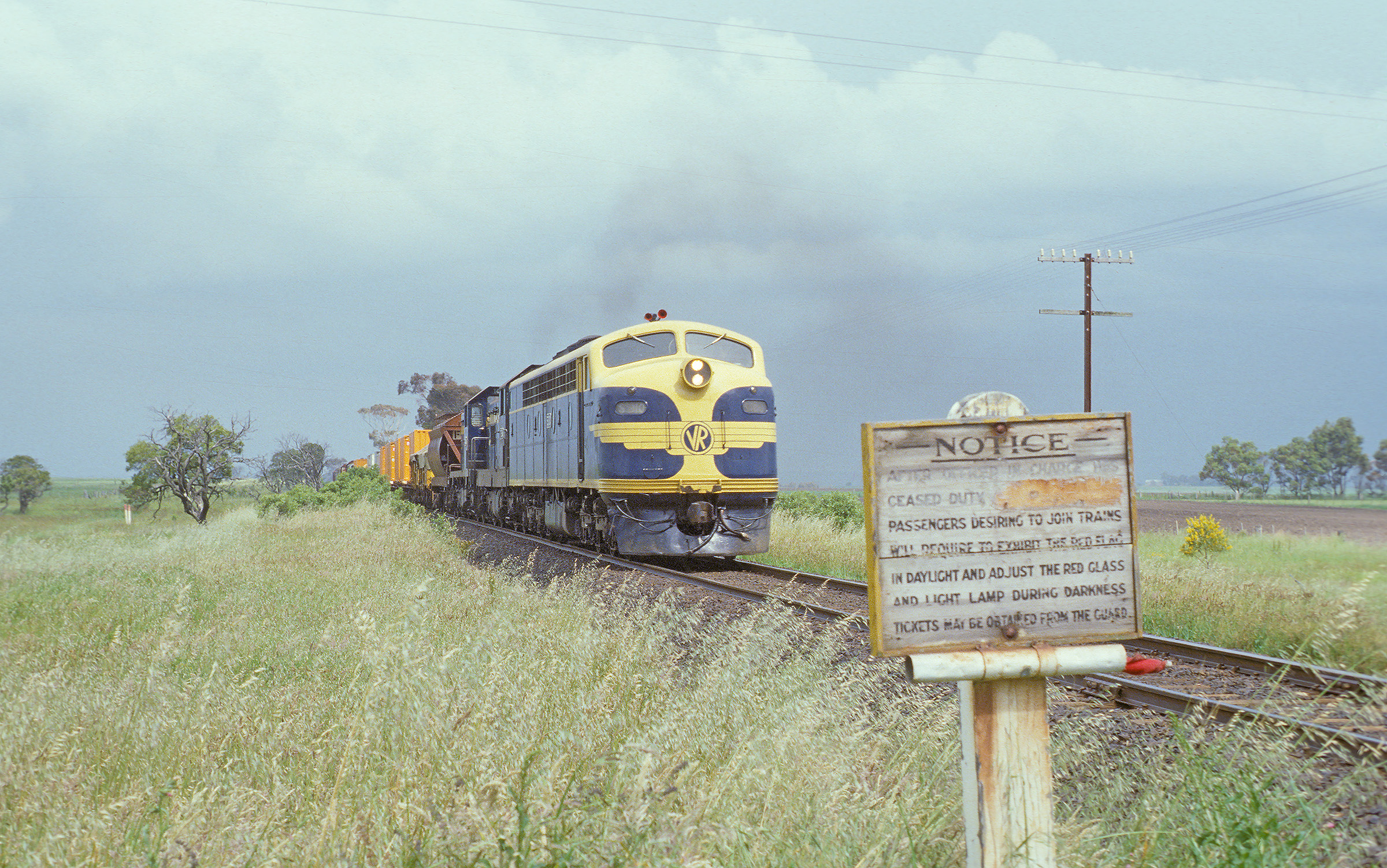
ABOVE: S310, T354 & T400 steadily approach, ascending the grade with a down goods during the mid-afternoon of Sunday, November 11, 1978. (photo courtesy Geoff Winkler)
Medina was also referred to as ‘Medina Siding’ in early Working Time Tables as well as VR Annual Reports up until at least 1938. According to these Annual Reports, it appears that all inwards and outwards traffic consisted only of livestock.
The earliest reference occurred in 1903, with instructions issued for the provision of a ‘Signalman’s cabin’. In January 1910 signals were provided, (on the then double line), at mileage 65 ½ for the down direction only. In February it was designated as an unnamed ‘Block Post’ and in March it was given the name Medina.
It was closed in May 1910 and was reopened for the first months of each year until closure on April 20, 1914. This arrangement was presumably to cater for extra traffic during the grain season.
In April 1924 a siding was provided on the up side, apparently a little closer to Meredith at mileage 66. An up home signal was also provided
In July 1932 it was disestablished as a double line block post and the down signals were removed. It is unclear whether these were the original 1910 signals, or others provided later.
In July 1934 the line was singled between Lethbridge and Meredith. Medina was opened as a ‘Switching Electric Staff Station’, to be used for seasonal traffic only. The siding remained and a crossing loop was provided.
In 1939 the switching equipment was removed and the crossing loop and all signals were abolished in 1941. The siding was closed in 1942, but the station was still available for use as a ‘Special Block Post’ until February 1950.
On April 5, 1954, ‘Rail Motor Stopping Place’ number 52 was opened at mileage 66 miles 65 chains 46 links. On the 5th of August 1963, this was relocated to the previous site of Medina, at Mileage 66.
The stopping place was officially closed, along with all others on the line, on July 18, 1978. From this date designated road coaches were implemented for the transport of school children. As the rail motor increasingly suffered mechanical problems from around this time, it was more frequently also substituted by road coaches. On March 18, 1981, this replacement was made permanent.
The information board provided for intending passengers, in situ at least during the final years, was of a generic type, usually seen affixed to unattended station buildings. Surprisingly, the red flag survived beyond the end, although in a rather tatty state.
Lethbridge signal diagram 9-1934
Lethbridge signal diagram 11-1934

ABOVE: The fireman on B 77 on an up Ballarat to Geelong goods exchanges the electric staff with the signalman at Lethbridge. 1981. The section Lethbridge to Meredith was single tracked in 1934.
BELOW: The following three photos show T 359 hauling a rake of Tait cars for scrapping arriving at and then crossing RM 32 on an up Ballarat to Geelong service at Lethbridge, July 11 1978. (photos coutesy Geoff Winkler)
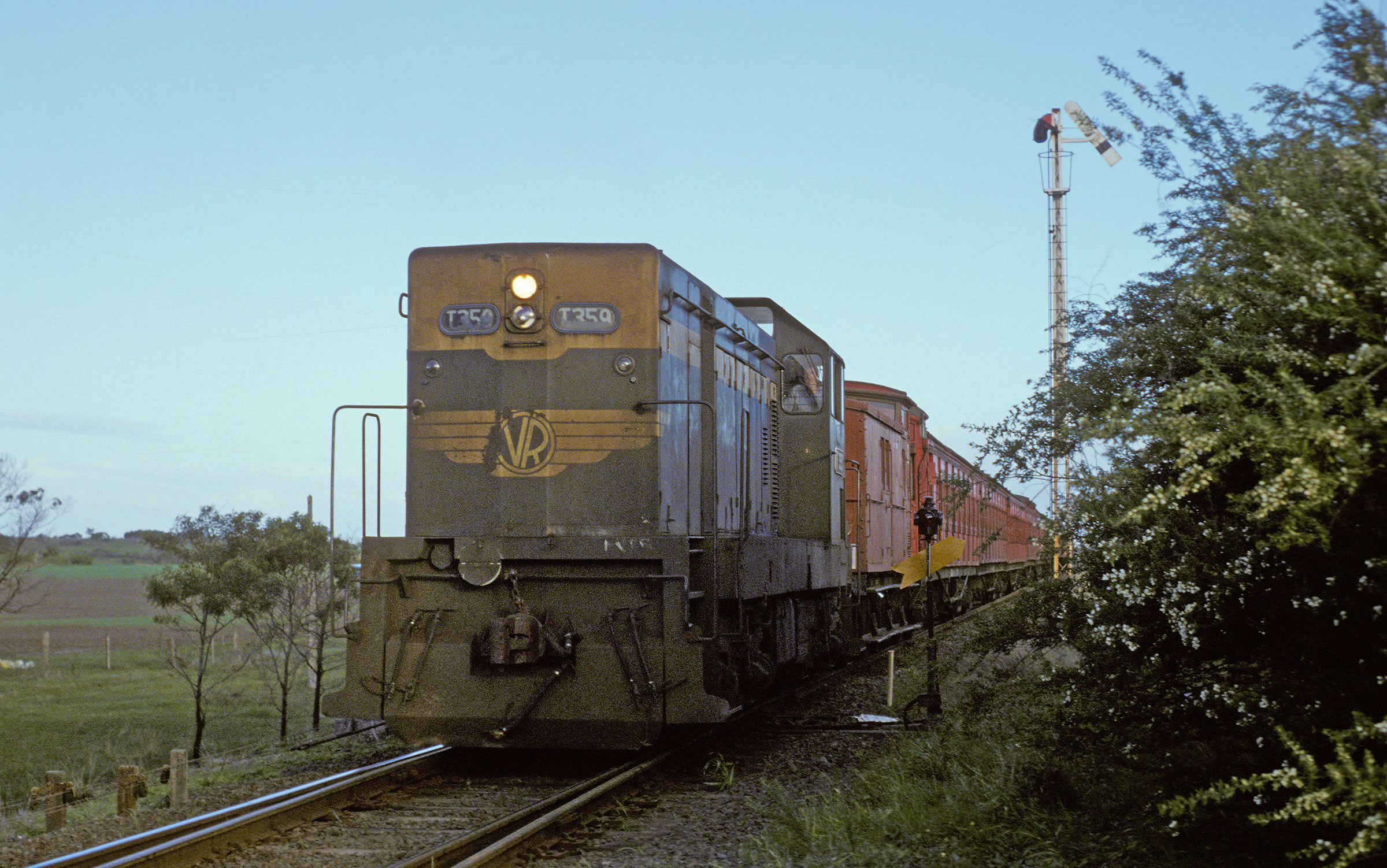
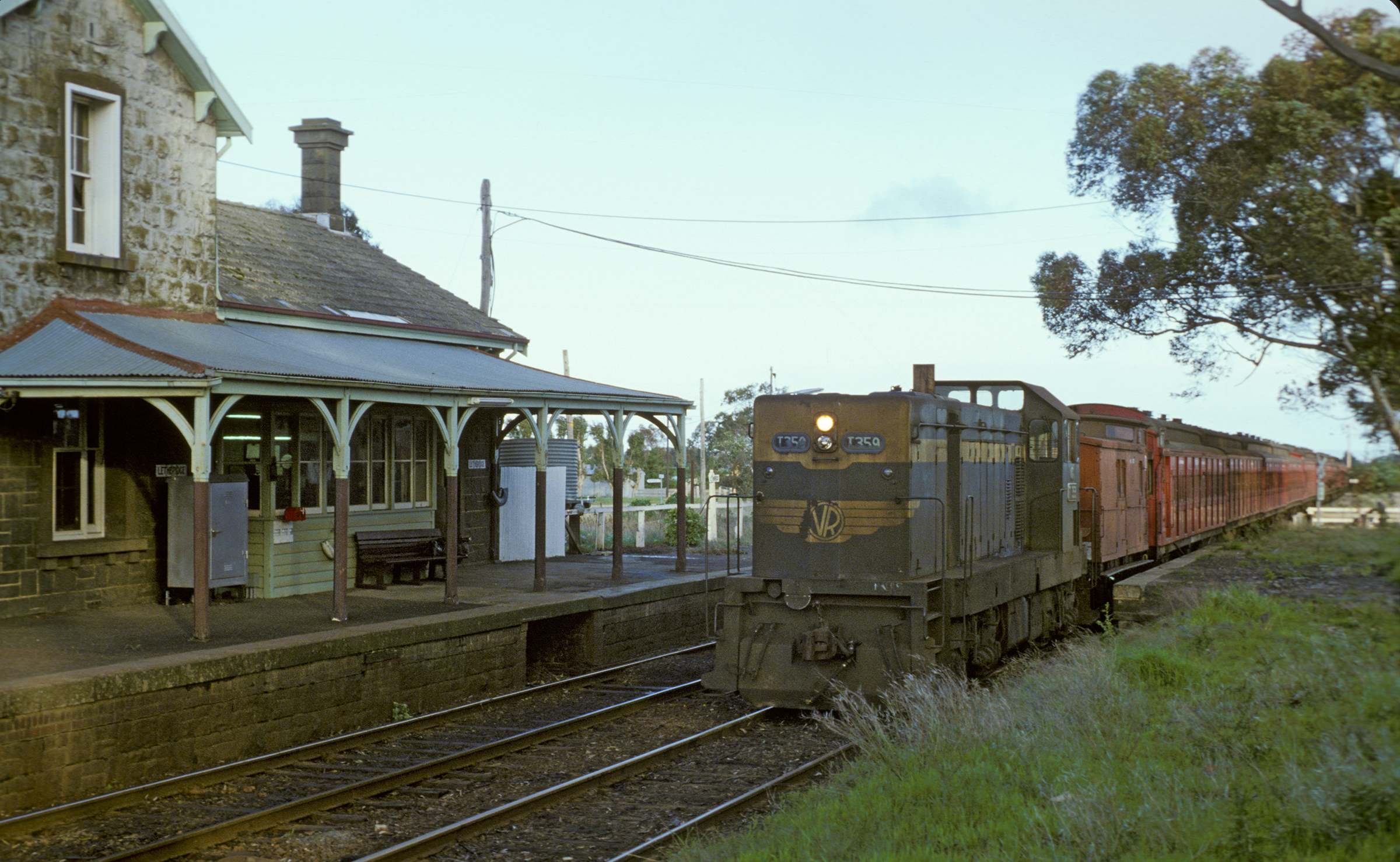
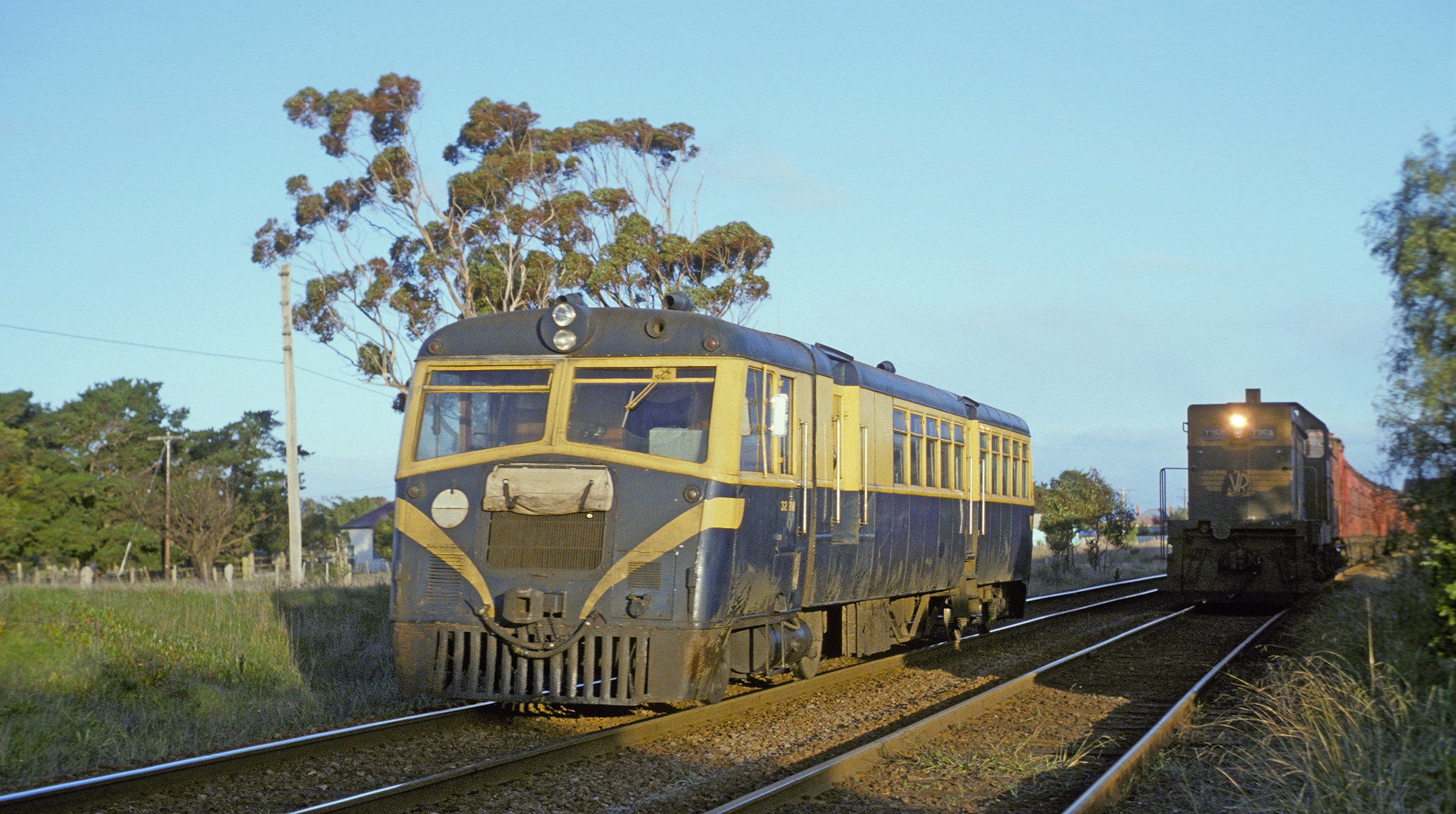
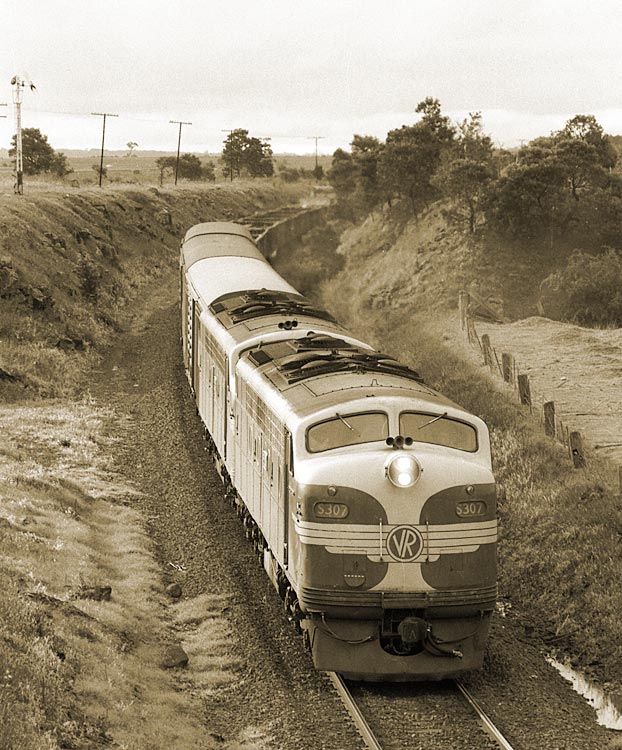
ABOVE: S 307 and 305 on #9144 up interstate express goods pass the up distant signal for Lethbridge. Sep 28 1981.

ABOVE: The Double Wire Control frame at Lethbridge, 1981. The two levers on the right are in the reverse position. As trains got longer, crossing loops had to be lengthened which meant that it was impossible to control the turnouts with traditional point rods due to the distance from the signal box. These frames used a pair of wires to control the points and could be used over much greater distances. They were very common all over Europe. They were not used much in Victoria because by the time we started installing them, power operated points and Dual Control Point Machines were becoming easily obtainable.
Meredith signal diagram 10-1934
Meredith signal diagram 13-1934
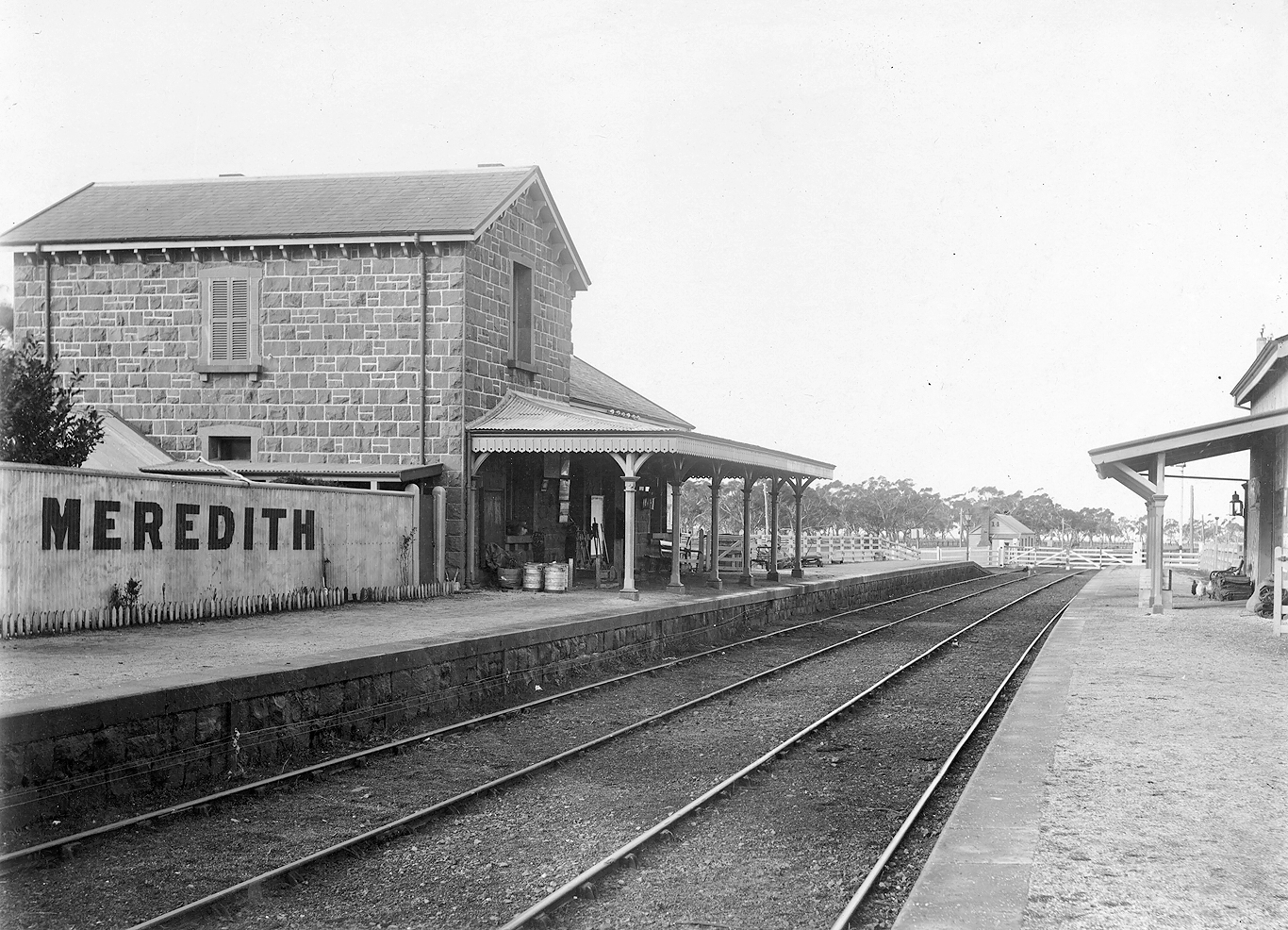
ABOVE: Meredith, looking towards Geelong, probably not long after opening. BELOW: A very similar view taken on Dec 29 1981.
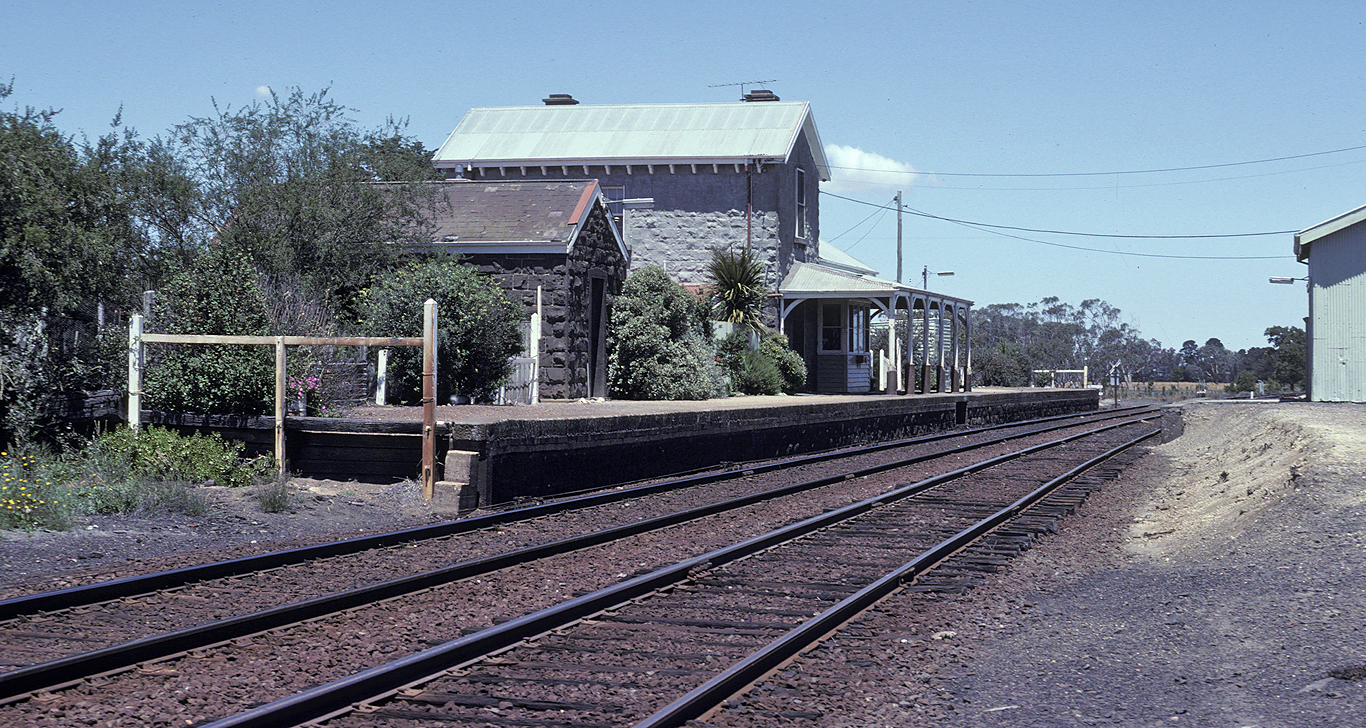
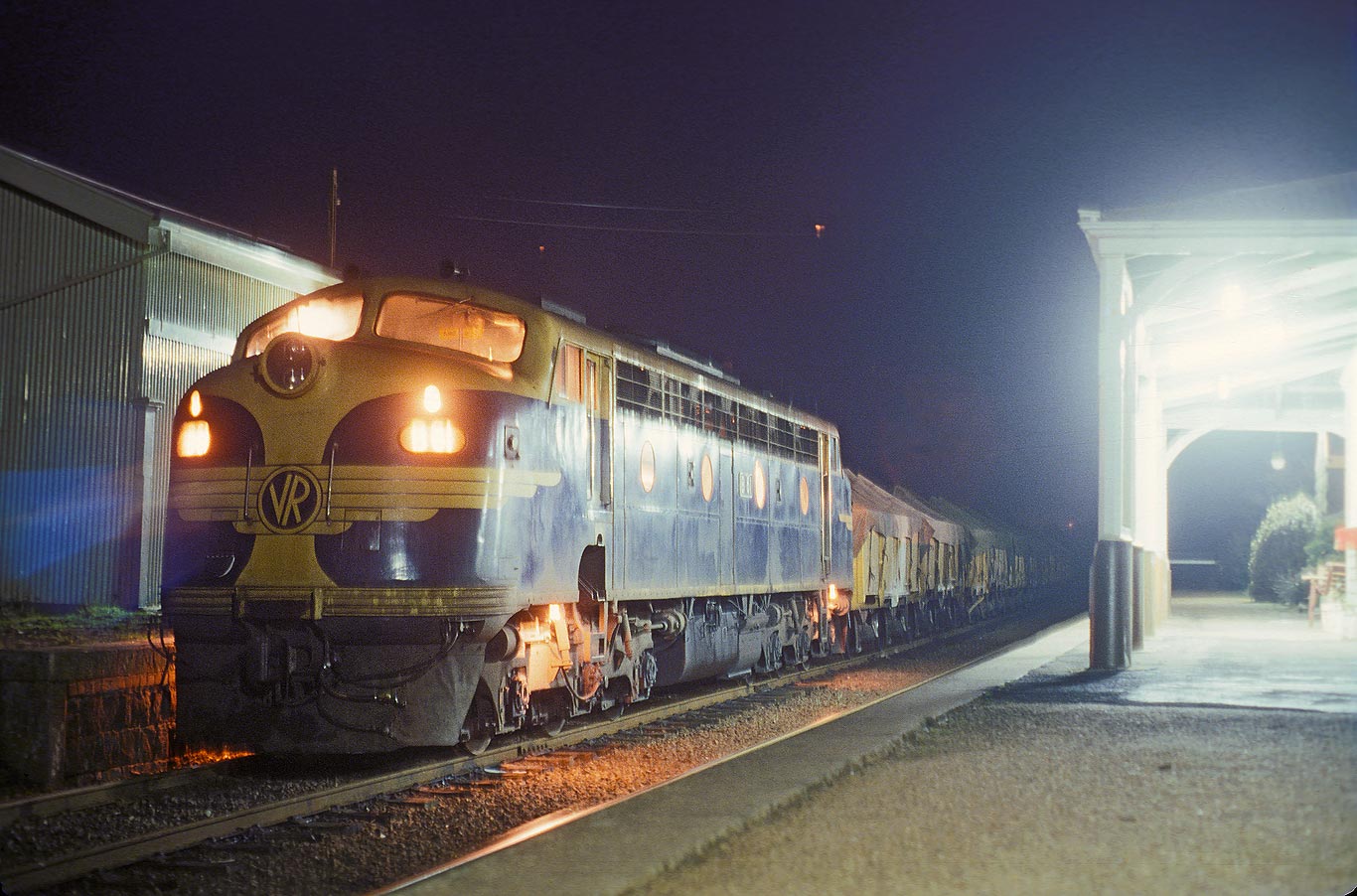
ABOVE: B 61 waits for a cross on an up (Ballarat to Geelong) goods at Meredith. June 19 1978. (photo courtesy Geoff Winkler)
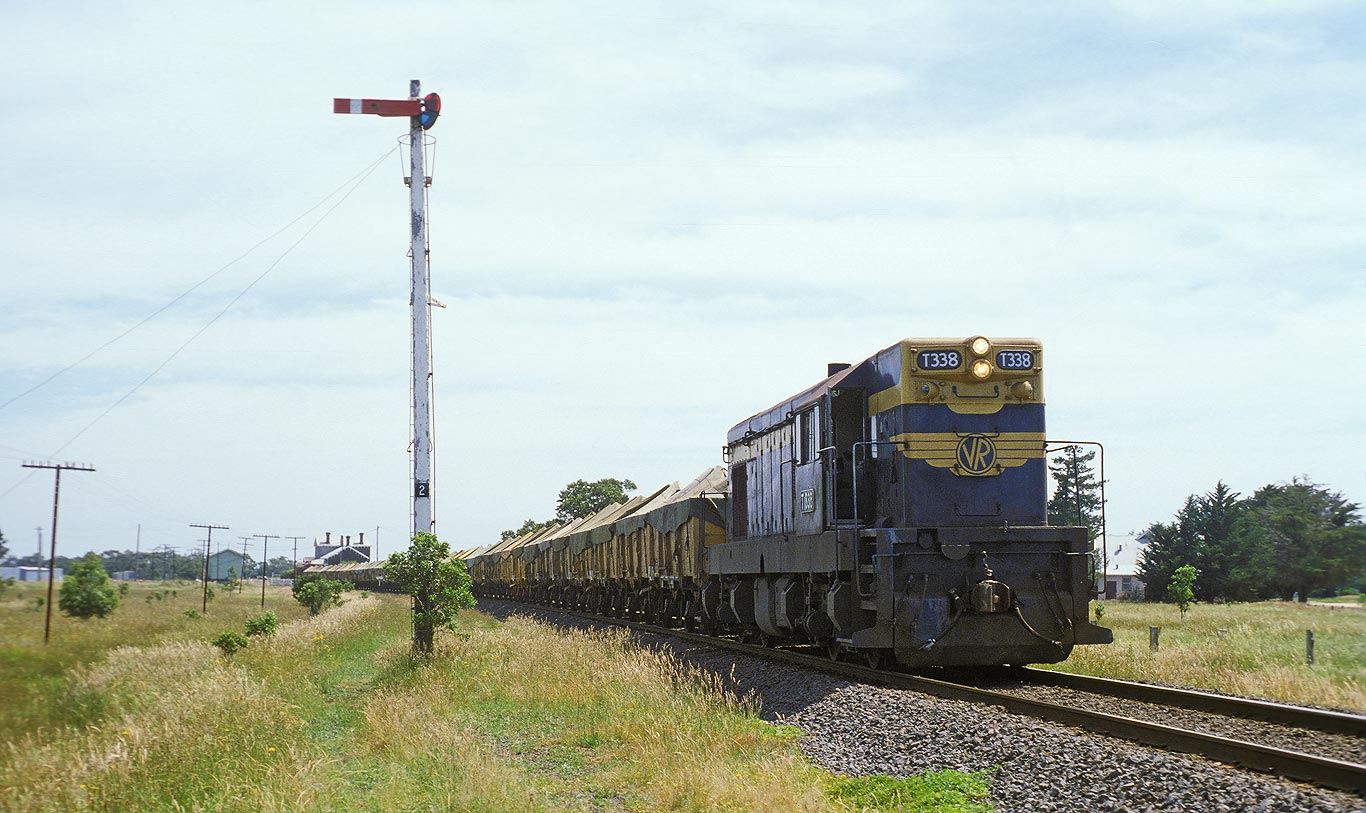
ABOVE: T 338 is on an up goods that has stopped with the van on the platform to attend to vangoods at Meredith, the signal (post 2) is the down home arrival. Nov 28 1978. (photo courtesy Geoff Winkler)
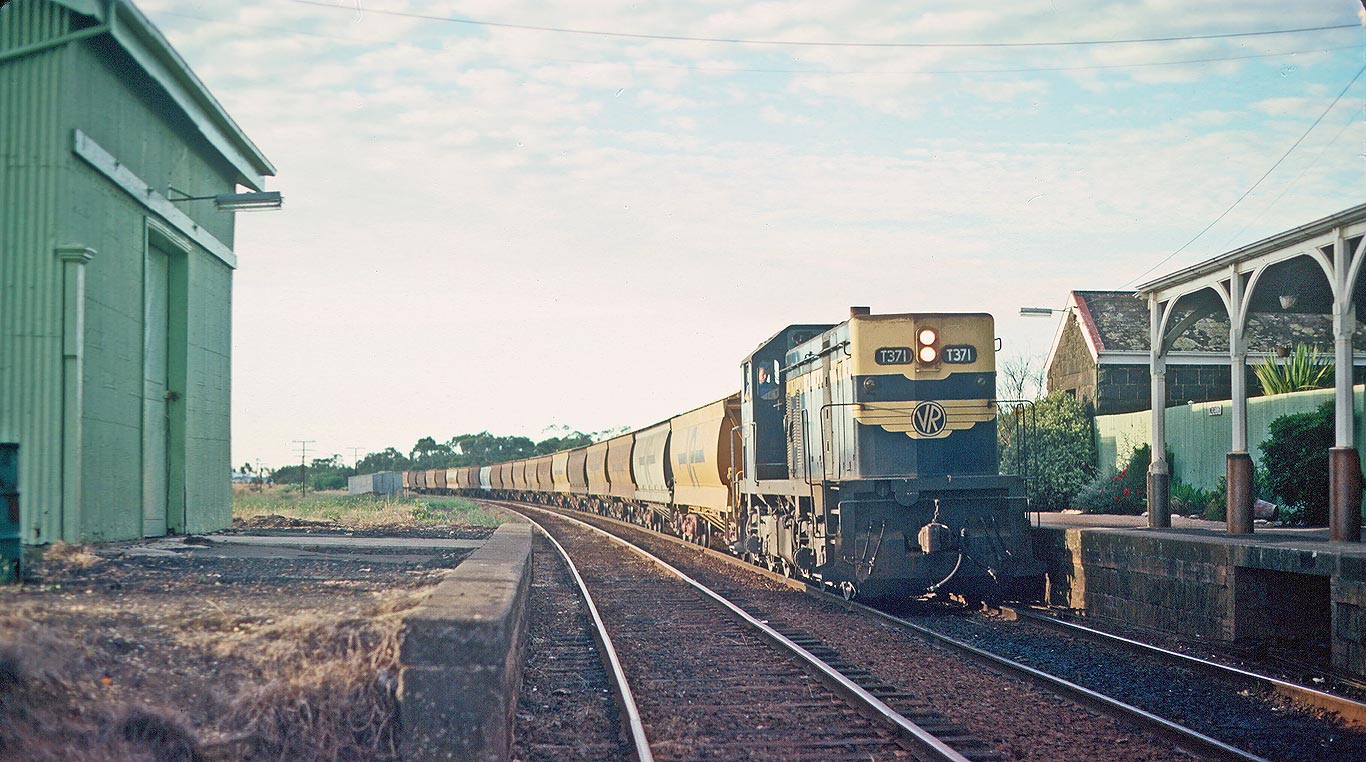
ABOVE: T 371 on an up goods at Meredith, Feb 1979. (photo courtesy David Hewitt)
Unlike the other main stations on the line, Elaine did not get a grandiose bluestone station building as it opened 10 years after the line opened by which time buildings of more modest proportions were in vogue.
Plan of Elaine's goods shed, waiting room and urinals.
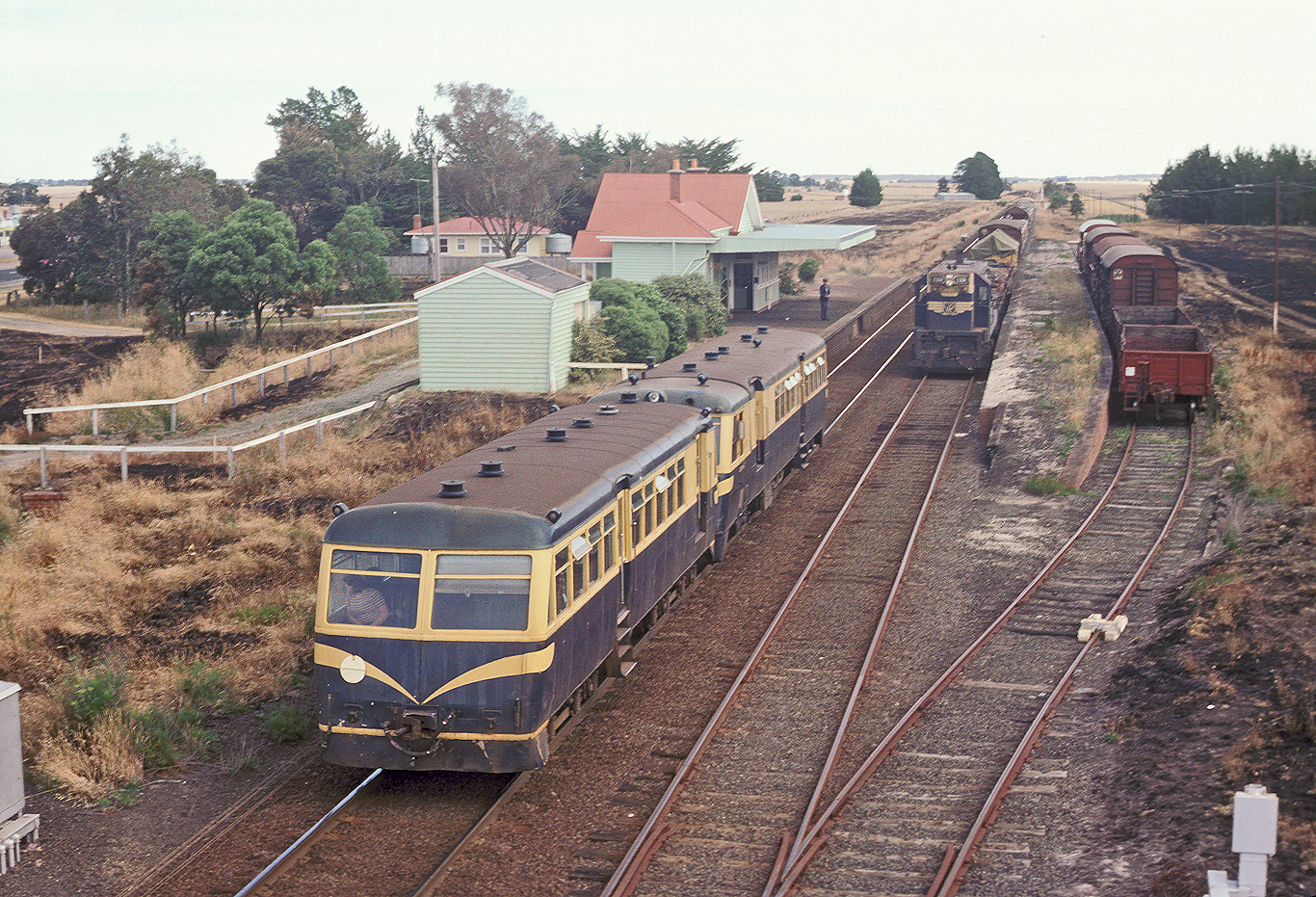
ABOVE: RM 22 - MT 54 on a Geelong bound service crosses T 331 on a Ballarat bound goods at Elaine, Dec 20 1977. The station building shown dates from 1913. (photo courtesy Geoff Winkler)
Lal Lal signal diagram 20-1934
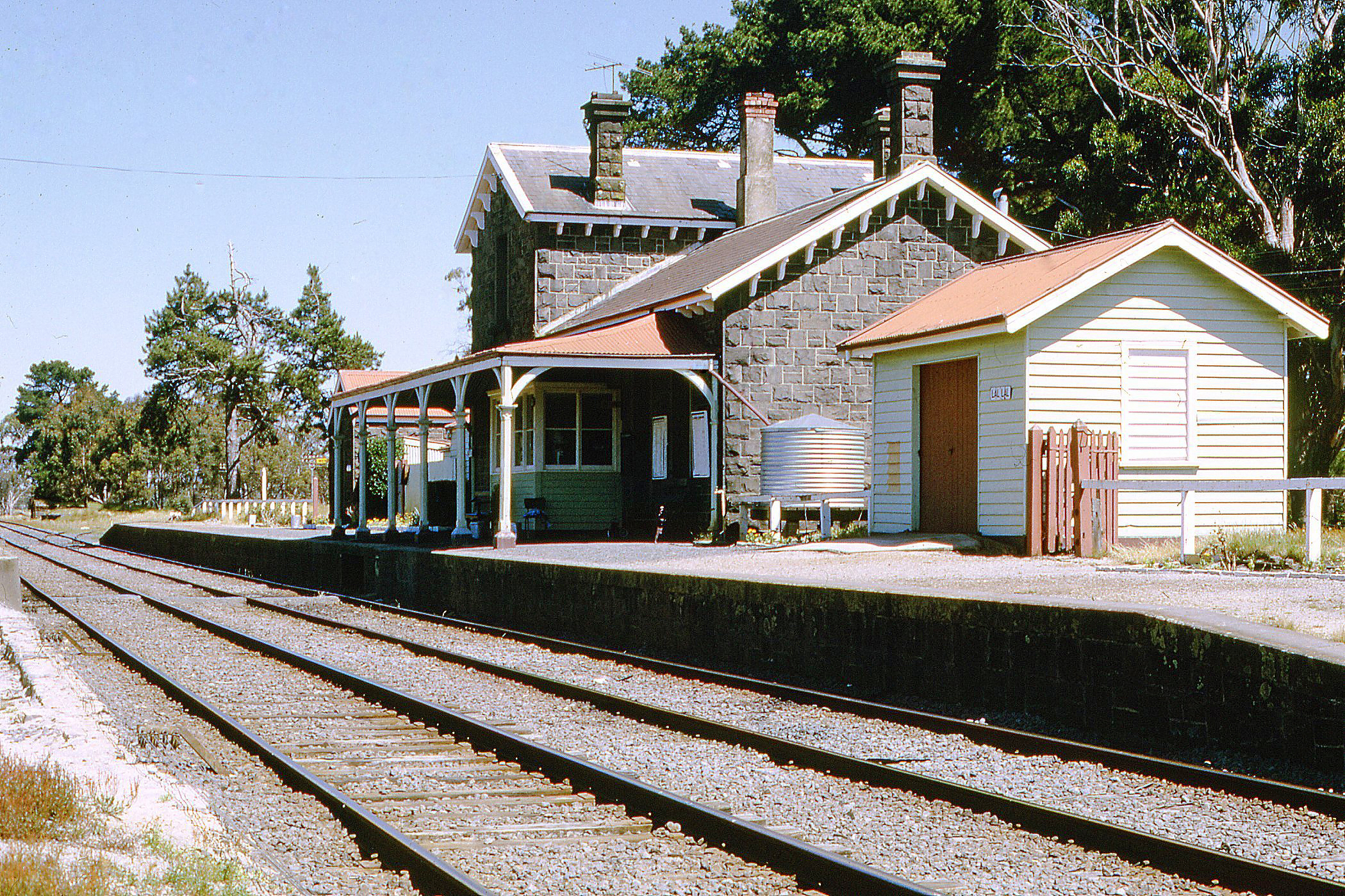
ABOVE: Lal Lal station 27 December 1969. (photo courtesy Neville Gee)
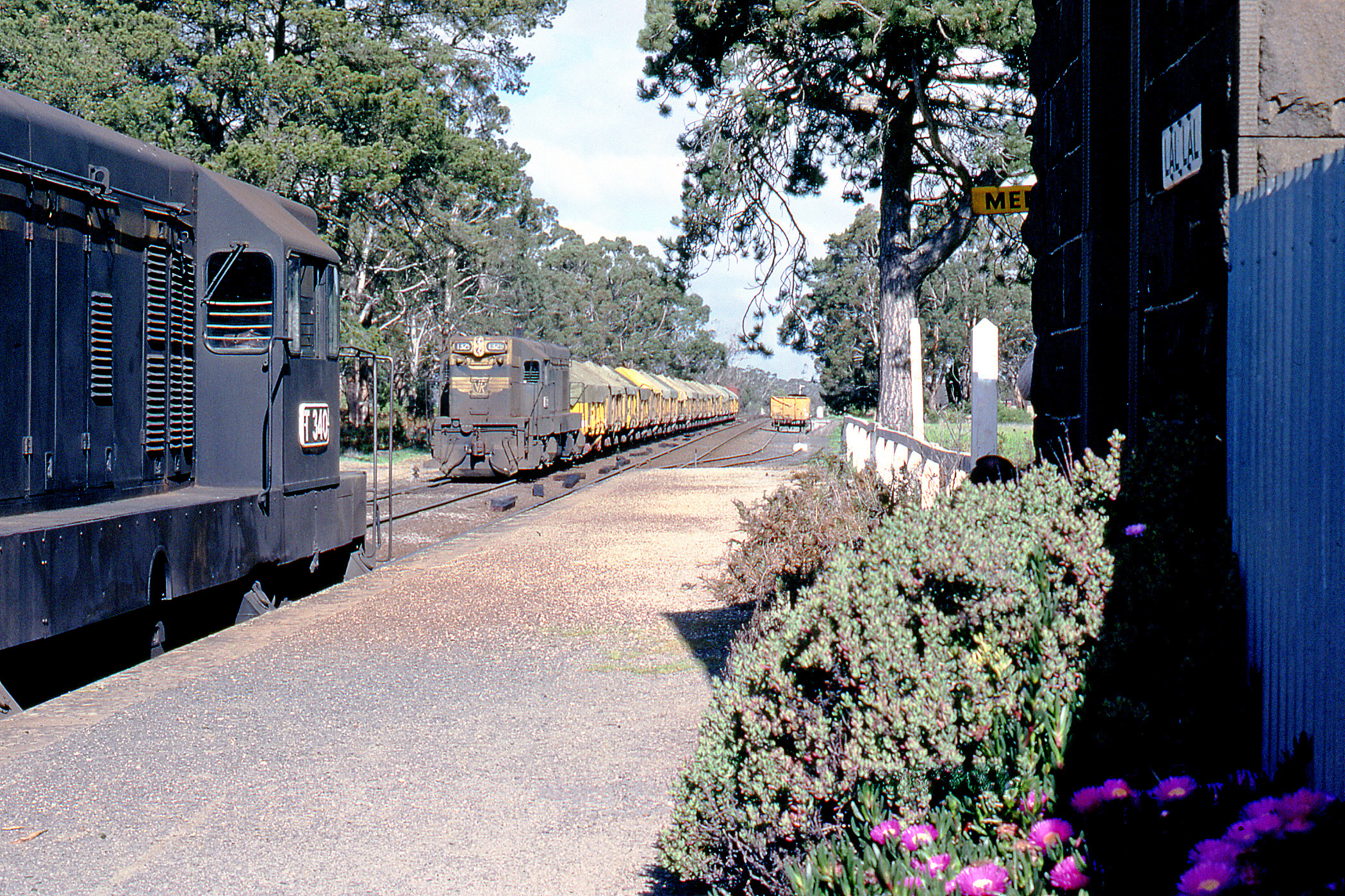
ABOVE: T 340 on a Geelong bound wheat train crosses T 329 on a down empty wheat train at Lal Lal. October 1980. (photo courtesy Neville Gee)
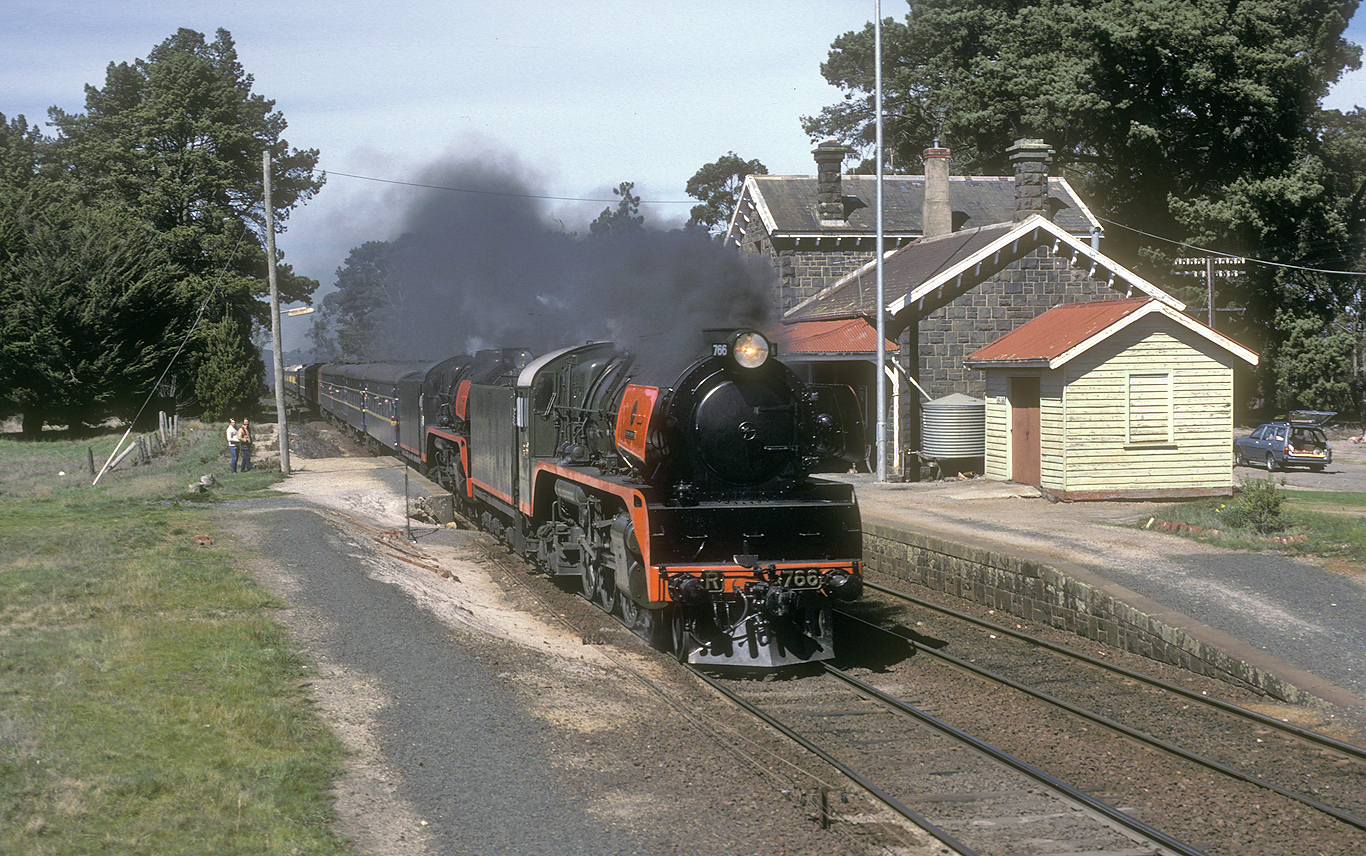
ABOVE: A pair of R class on a down enthusiast special power through Lal Lal, Sep 1985
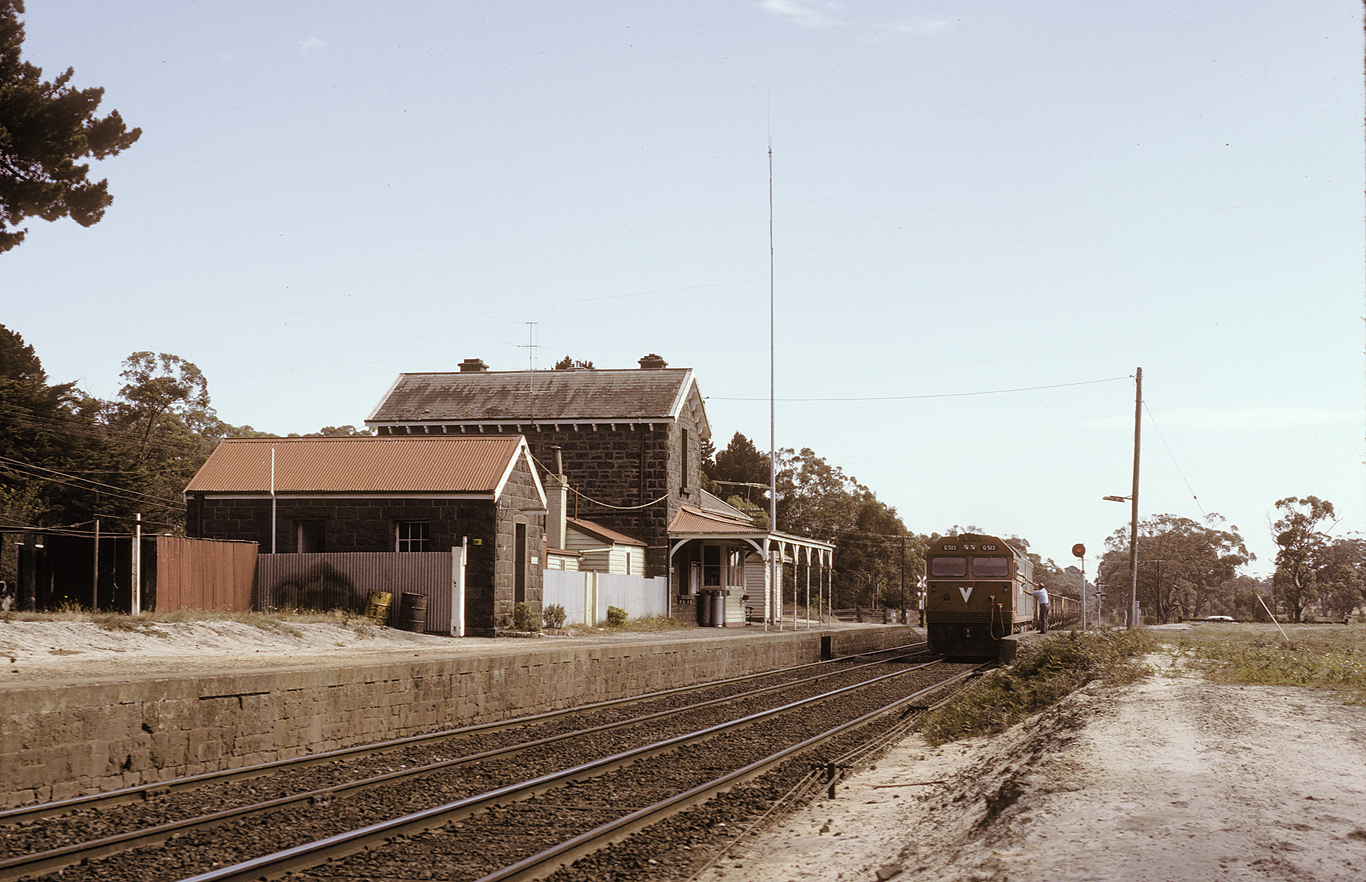
ABOVE: Lal Lal looking towards Ballarat. April 3 1986. The section Lal Lal to Warrenheip was single tracked in 1934.
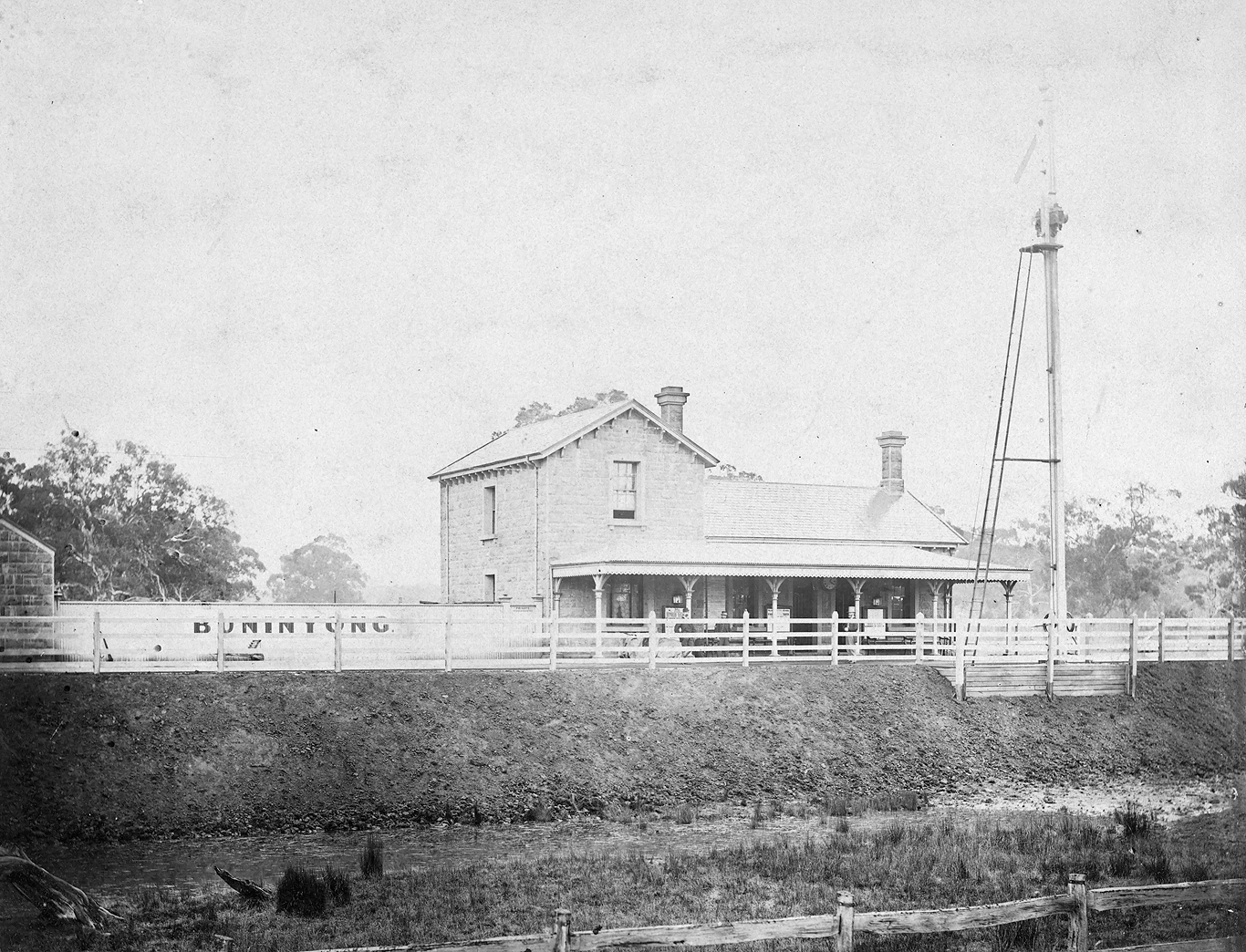
ABOVE: Very early view of Yendon station. (Yendon was named Buninyong when built) Sadly this building was demolished in the 1960's.
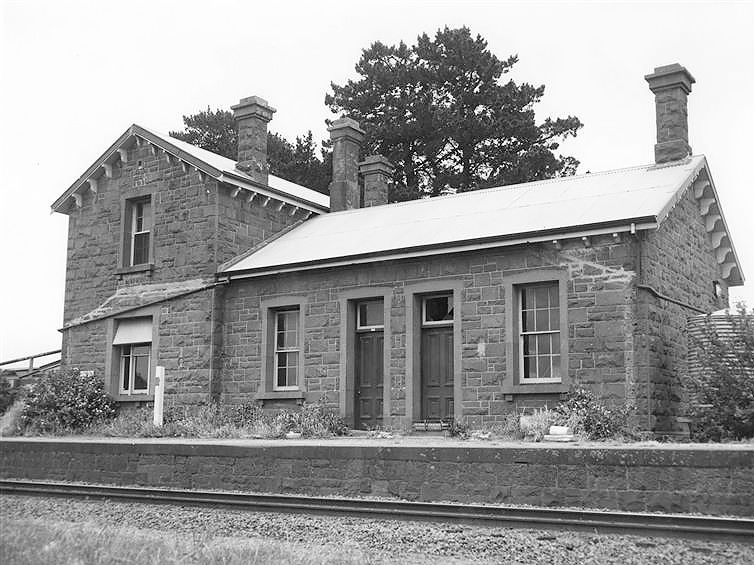
ABOVE: At some point Yendon lost its verandah, this photo was probably taken not long before it was demolished. (photographer unknown)
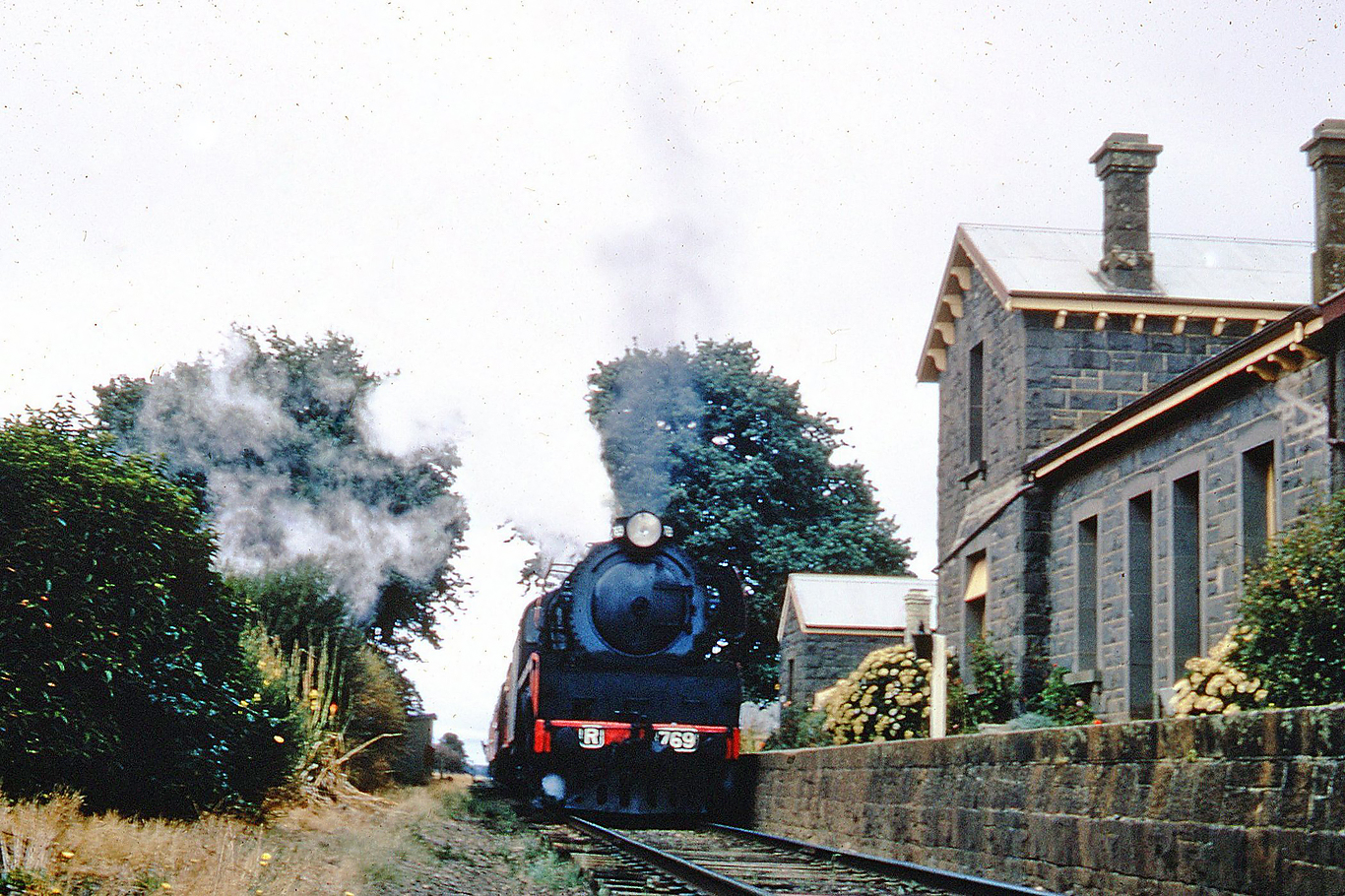
ABOVE: R 769 heads a special excursion through Yendon station shortly before it was demolished in the late 1960s. This was the only blue stone station of its type to be demolished and should never have been allowed to happen. BELOW: The sad scene, six months after the beautiful bluestone building was demolished, one really wonders what was acheived by such wanton destruction, Dec 27 1969. (both photos courtesy Neville Gee)
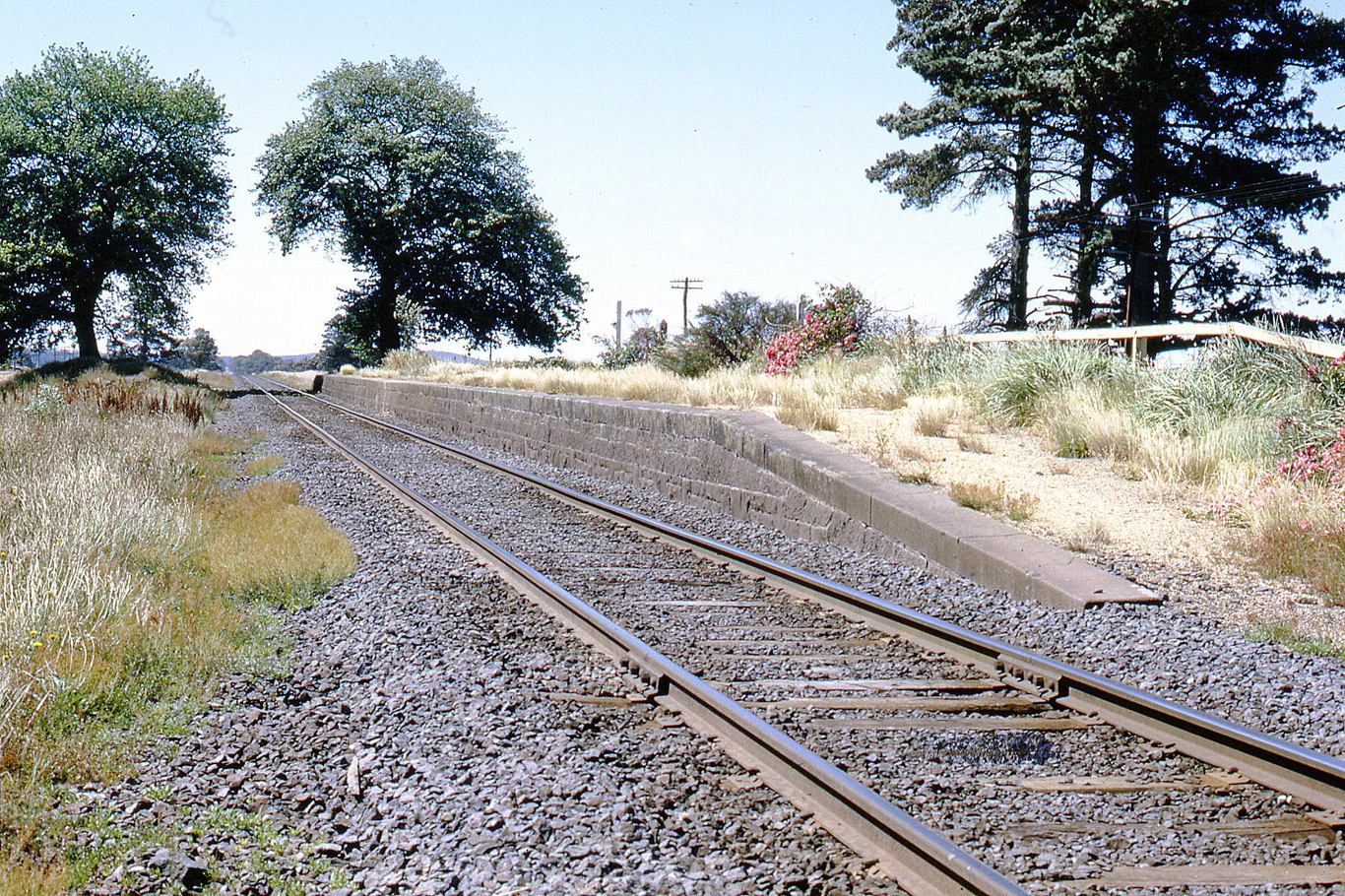
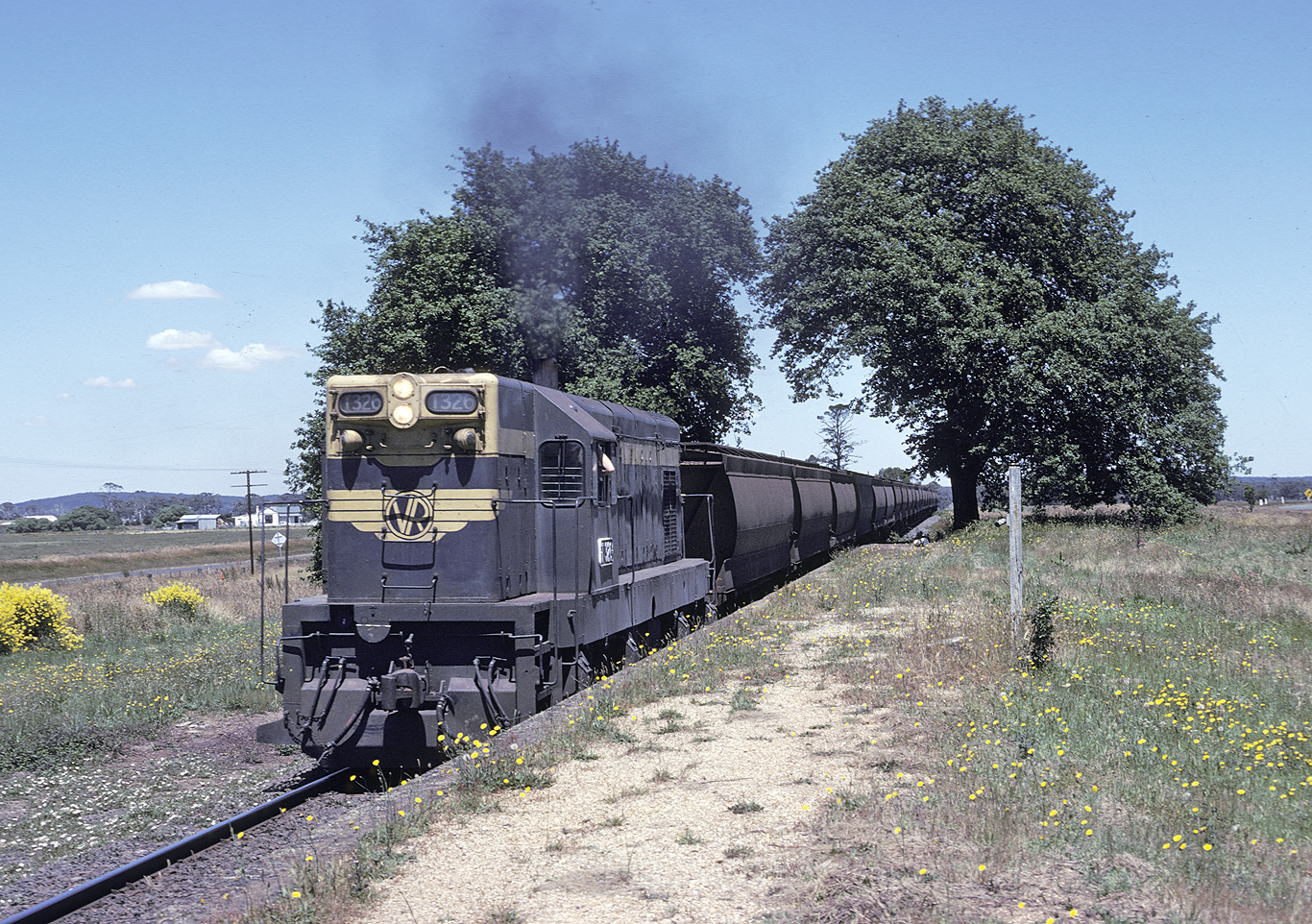
ABOVE: T 326 on a down empty wheat train at the platform at Yendon. Feb 1982.
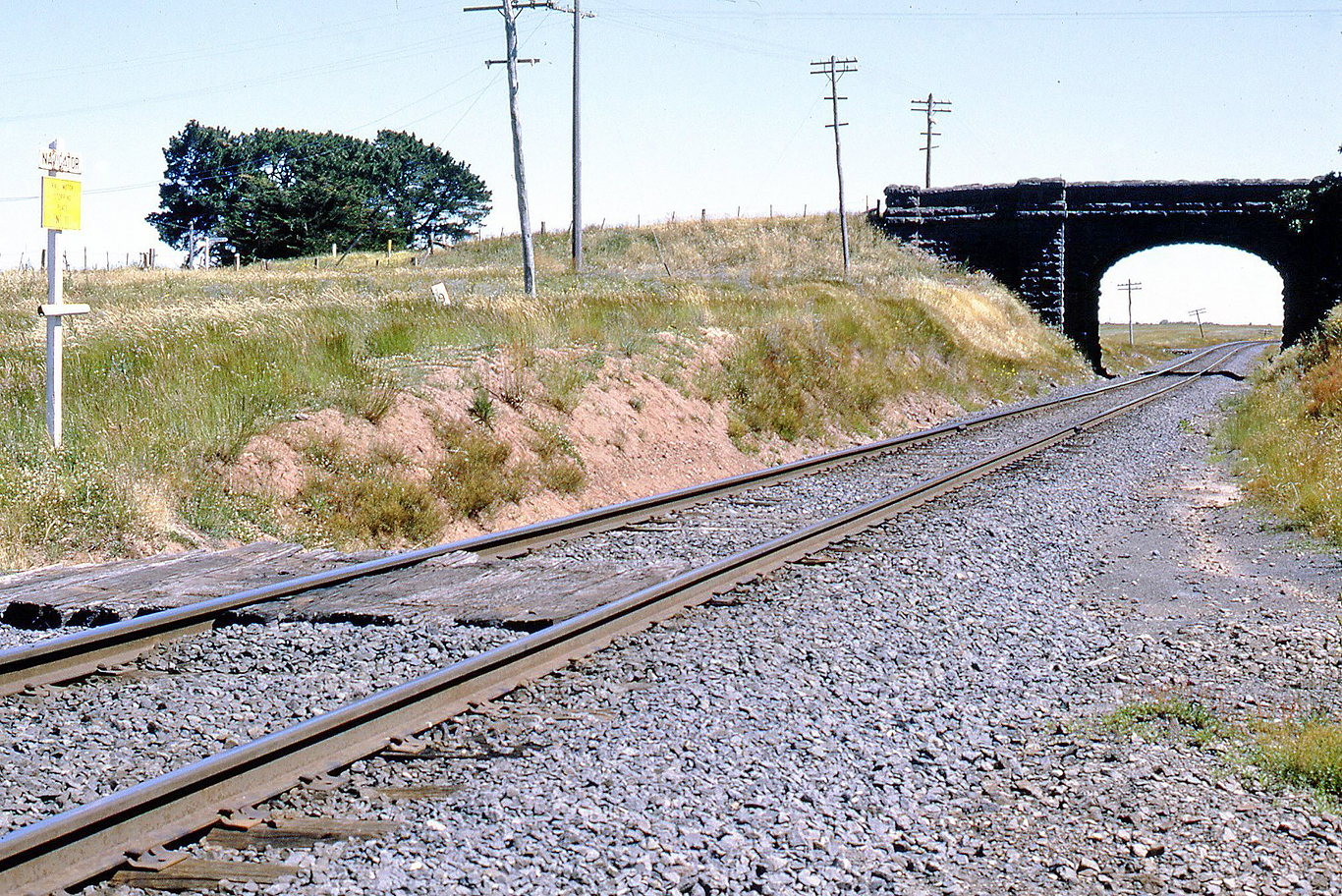
ABOVE: Navigator station, or Rail Motor Stopping Place No 11 as it was by this time. 27 December 1969 Note the 90 mile post from Melbourne, (via Geelong) almost hidden by grass. (photo courtesy Neville Gee)
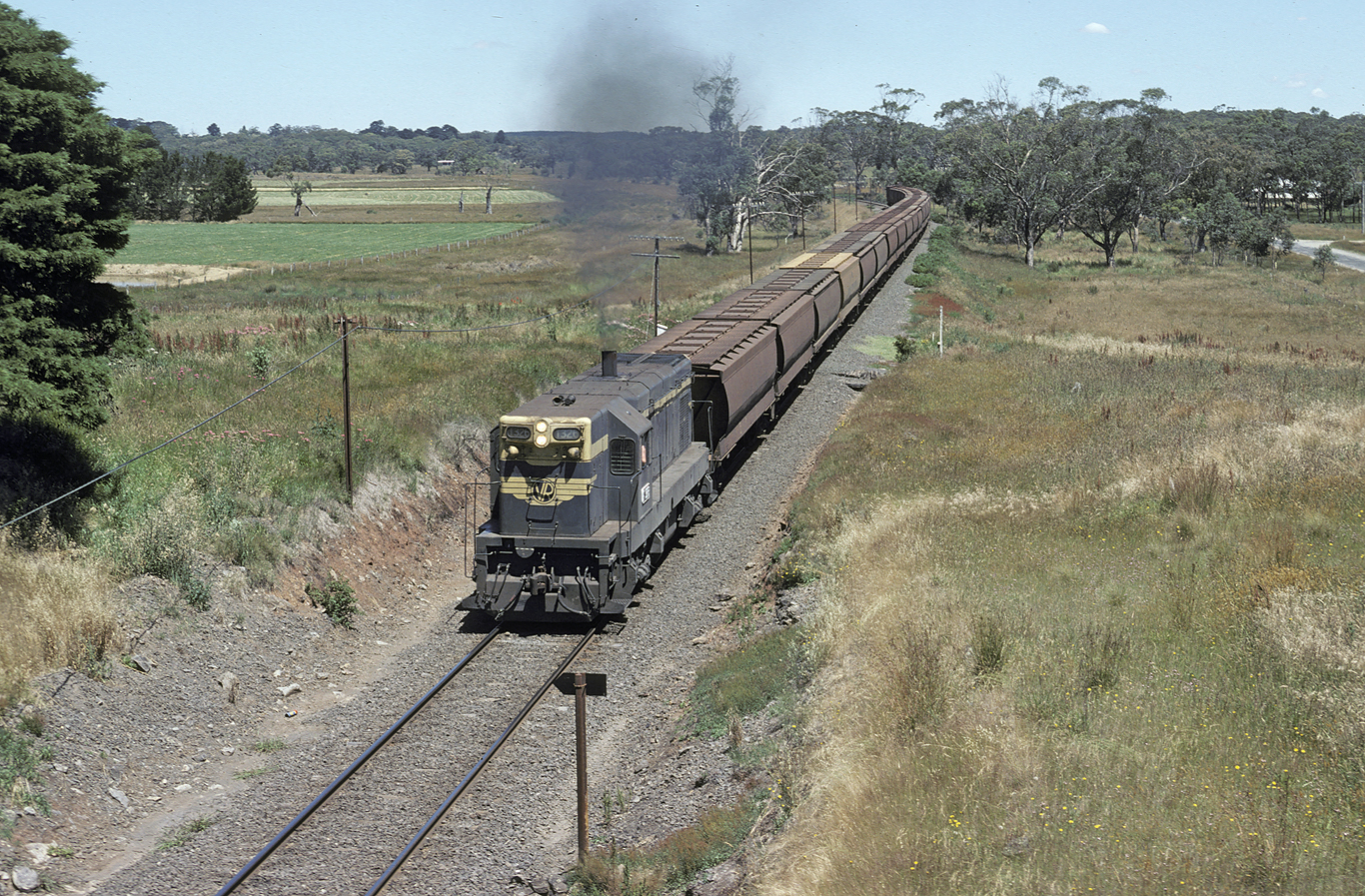
ABOVE: A Geelong to Dunolly empty grain train at the former station site of Navigator, between Geelong and Ballarat. Feb. 1982. Navigator was closed as a station Dec 1956 at which time it became Rail Motor Stopping Place 11. The photo above this shows the bluestone overbridge that this photo was taken from.
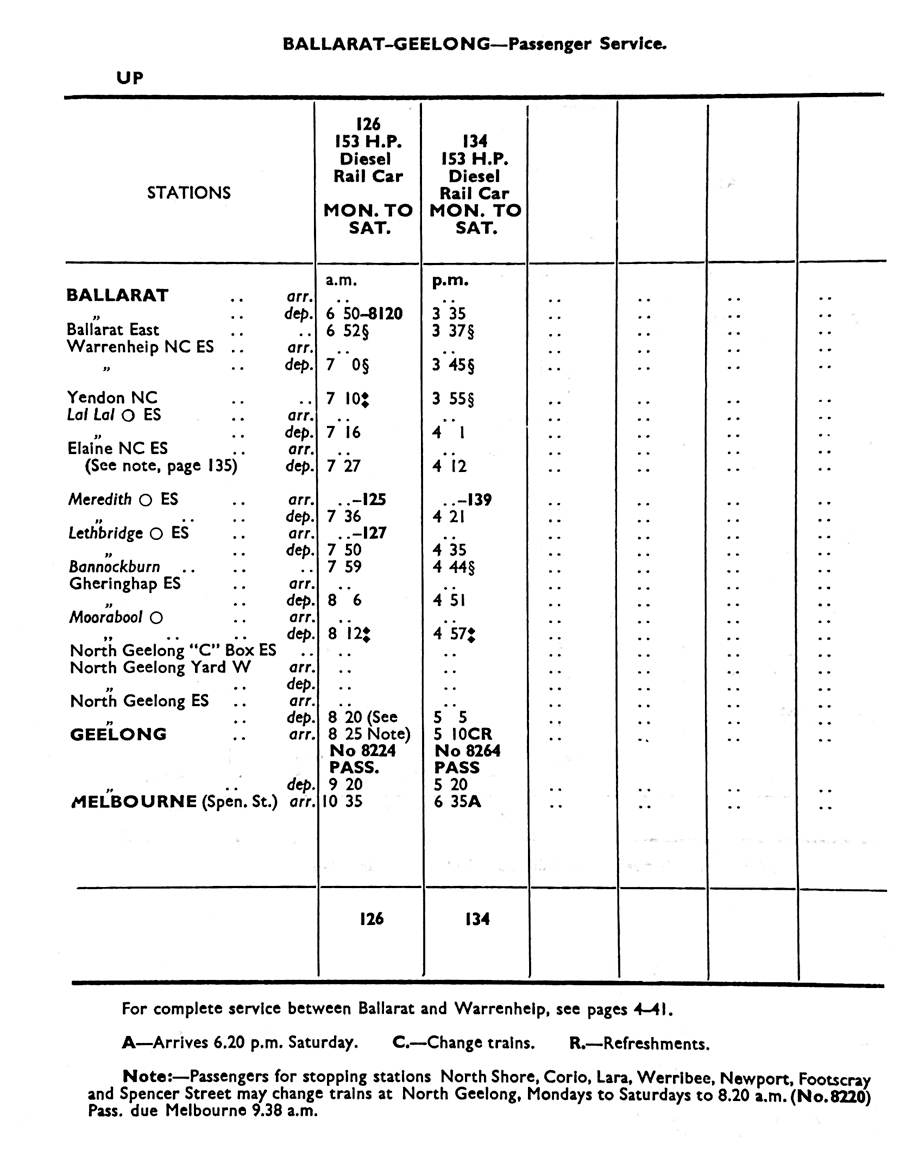
ABOVE: A page out of the Oct 1979 Working Time-Table. The photo at Elaine is almost certainly of Train No 134, the afternoon Ballarat to Geelong service. The letters ES after a station name meant that it was electric staff station. Elaine was able to be switched out, the other ES stations were permanent electric staff stations.
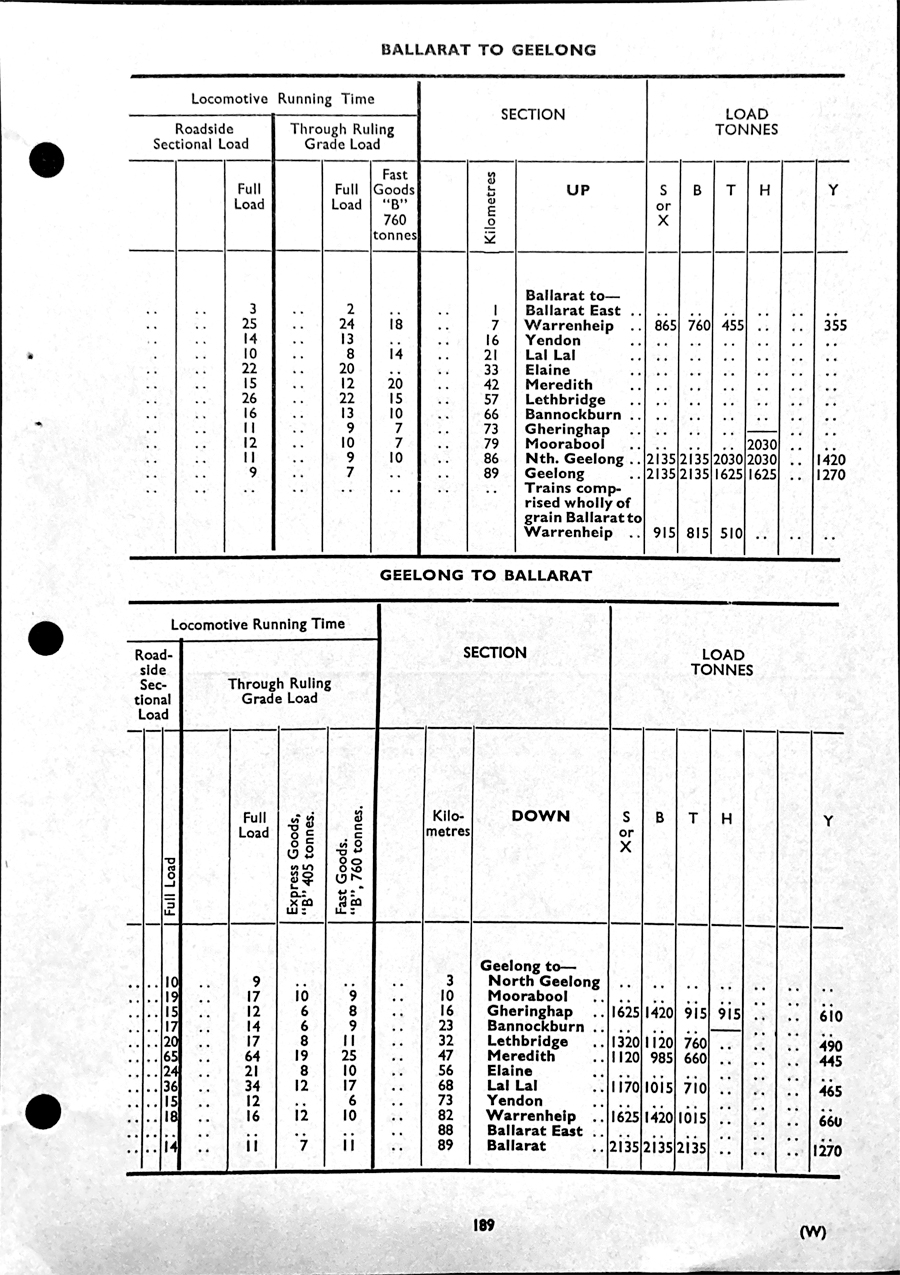
ABOVE: Page out of the Oct 1979 Working Time-Table showing the maximum loads allowed for various classes of loco. The line from Warrenheip to North Geelong was almost continually downhill which is why a through load for a T class from Warrenheip to North Geelong was 2030 tons but a through load in the reverse direction was only 650 tons.

This is the content for Layout P Tag